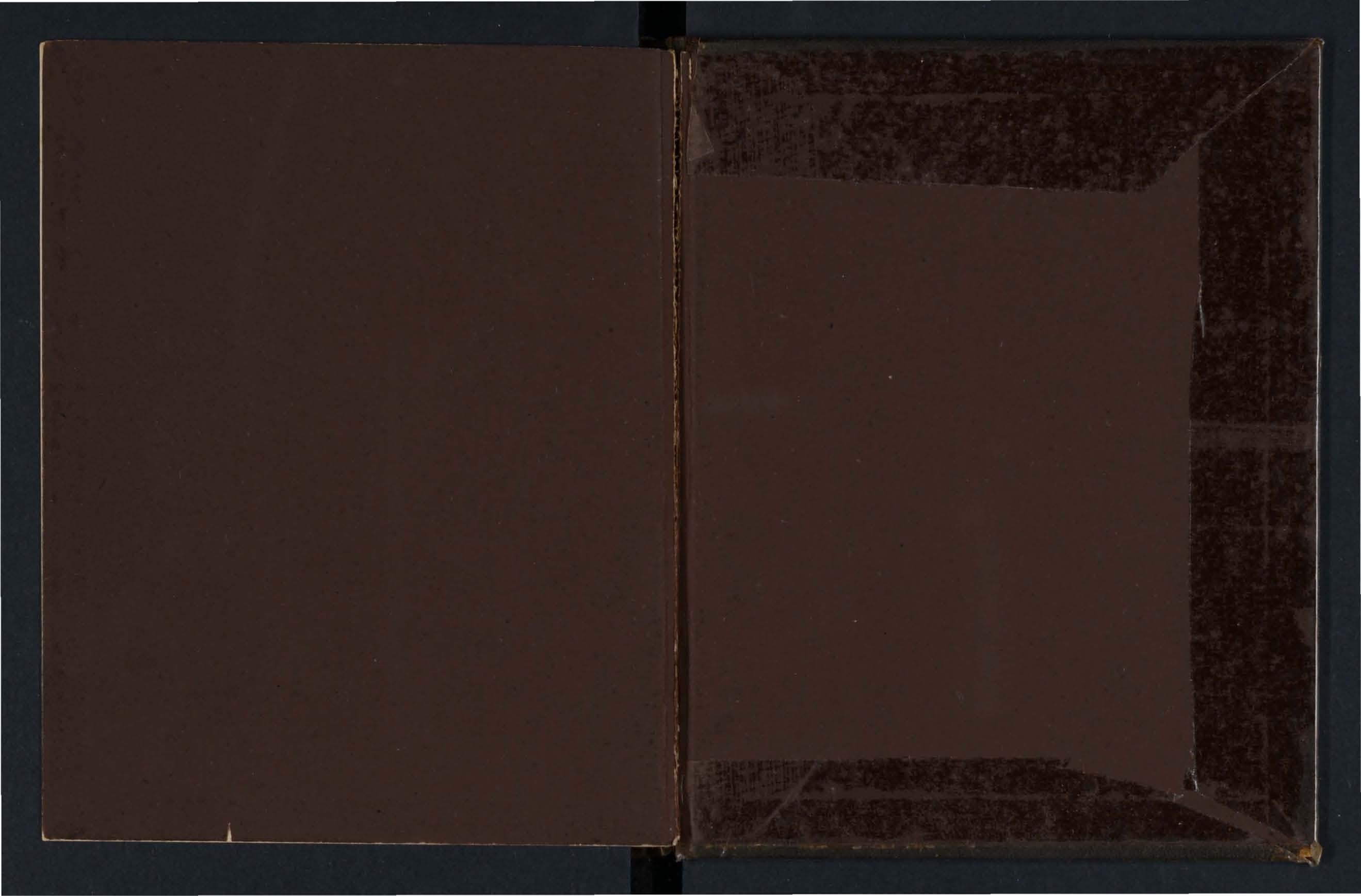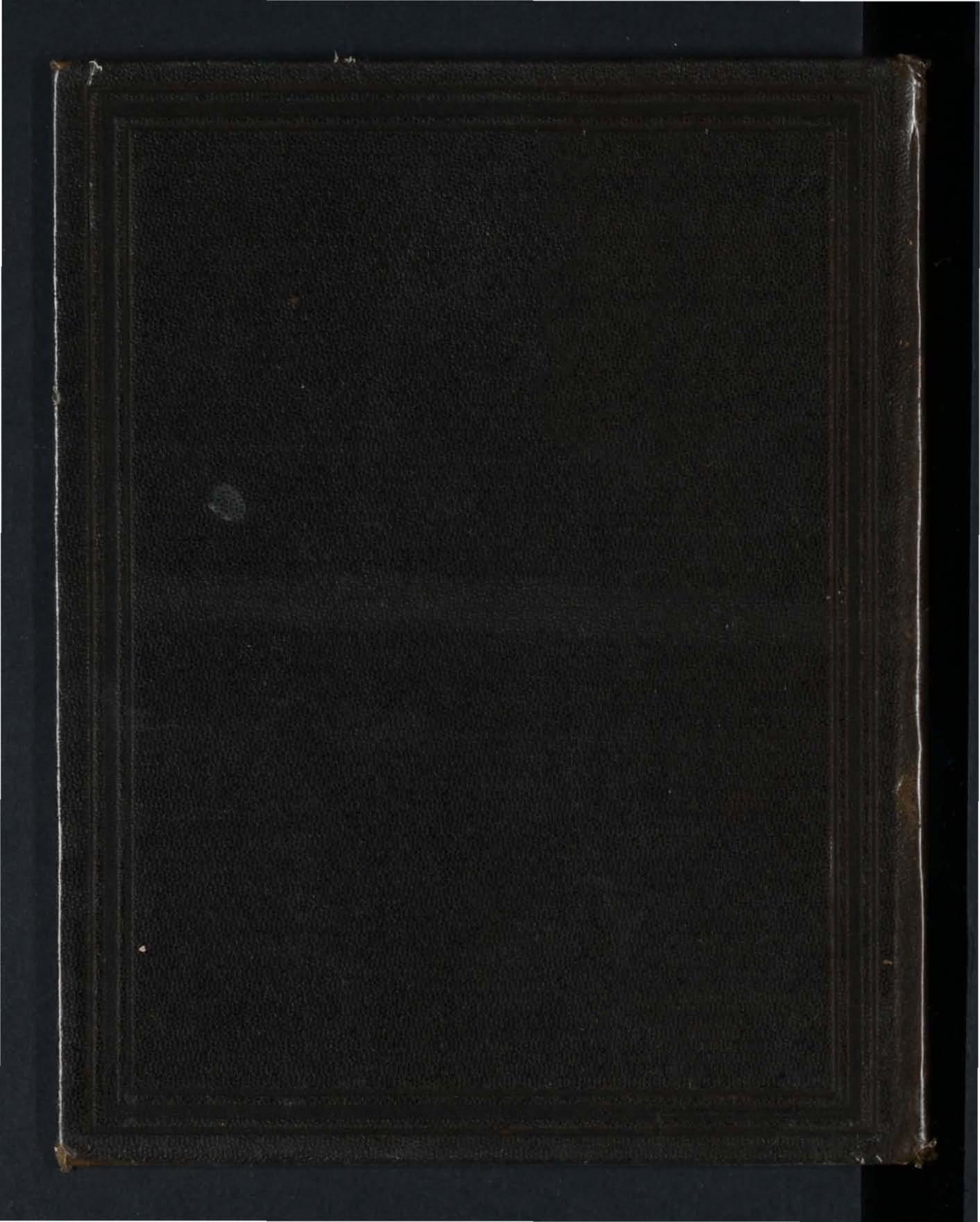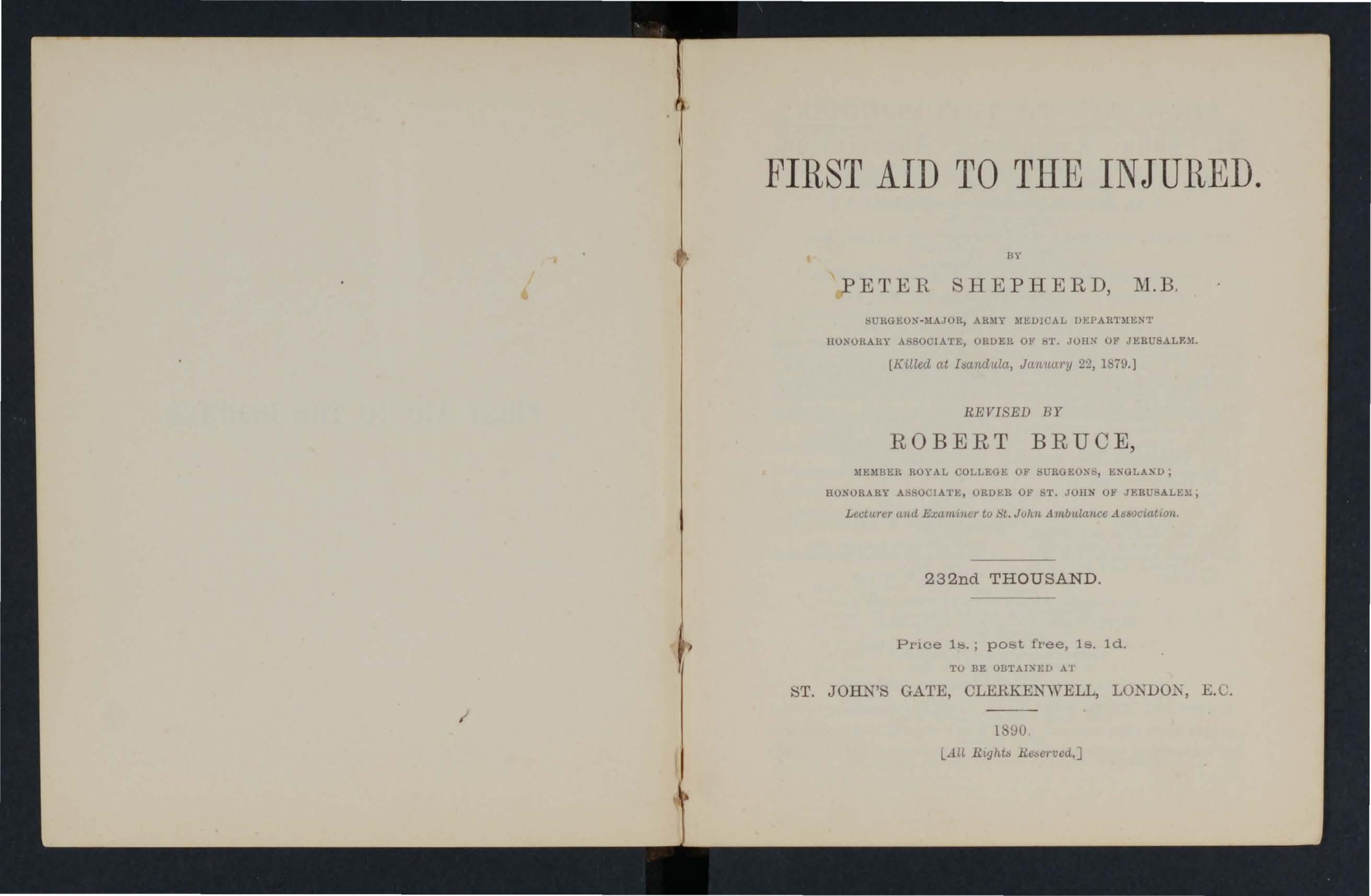FIR
ST AID TO THE INJURED.
JJ 0 btt J\-nthulantt J\-ZZOtt aiton,
BF.l);(1 TJlE OF 'Qt l)£ <1ir an'tr of tl)c @r'trrr of 11)£ 1l) os pUnl of
S 1. .3lobn of 3lcr usa l cm in <1 nglnn'tr .
T'rf"Ltil'lil : HIS ROYAL HIGHNESS THE PRINCE OF WALES, K.G, (GRA.·U I'HIOR 01,' TUE ORDl<:n), Centra! E t'ccutiU8 Committee: onsistlng exclusively of lIll'llllwrs aud Associates of the Order, OltairllWl1:
Bir EDMUND A, H, LECRMERE, Bart.• M.P., M.A., F.S,A Depldl/ ()It<lirllLt'1l : JOR' FURl;.,:\" Esq, Sir VINCENT B. KF.NNETT·B,\RH[!iGTON. M.A., LL.M. r,lON EL S BEALE. ESQ., :lr. D.• F.R.S. tilr Wrr.I.IMI MACCORMAC, M.A, ROBERT BRUCE. Esq., 1I1.R.C.S. F.Re.Fl.
RUPERT C. F. DALLAE<, ESIl. ROBKC1' MAOLKAN·l\1AOLKAN, Ea'l, Lieut.-Colonel J. C. DALTON, n.A, Mlljor G. K WYN :lIAI,l':'r. Sir THOMAS DICK-LAUDFIl, Bllrt W.l'. N. MANLIiiY, Esq" V.C. (SnrgcIlu- General SlrH. O. B. DAUBENF.y,t';.U.Il. General , Army Medical Dep art · WAYNMAN DIXON. Esq" M.LO.E. ment).
Major H. W . DmIVILE. SANDFORD MOORE, F:SI], lII.B., F,S,S
ROBERT FARQUHARSON, Esq"M.D" (Surgt'on-lIlajor , A.M. D.) . lII.P. OWEN. EStl, F.RO,S, PHILIP FRL'iK, Esq., M.D Ueut,-Colon('l Sir REllBEHT O. PF,R· LDWIN FRESHFIELD , ES'l., LL,D., ROTT, BRrt F,S.A, lIlajr,r-GuH'ral WHITWORTH I'OR
EDWIN FUESHFIELD, Esq., Jun. TER , "ILLIAM DAWEtiFRESHFIELD,Eslj" General Sir ST. GEORGE,
Lieut.-Col. JAMES GILDEA, F,S,A . R REYSOLDS RUWF. };"I" F,S.A.
SIr BROOK KAY, Bart. Sir l<:DWARD H, SIEYEKl!lG, M,D"
Tbe Rt, Hon, the EARL OF LIMEHICK. F,S.A. ('nlonelSir HENRY B. LOOH. K.C, b Sn:WAltT RUTHKltLA); ll, Esq. SIr THOMAS LONGMORE, C,B, (Sur' Lleut,-Colonel(;ioULD Hu. TEll,WKS geon-General, Army Medicnl De- F.S.A, partment), Rey. PAUL W, WYATT
Trra'<l,rers: Major-G en('ral WBITWoll'l'U rOI1TIHl, H.E, R1TPE:RT C. T<'. IJALLAR, EDWIN FRESH FIELD, LL.D .• B'.S,A., Ollie; SerrdfU!I LIeut.-Colonel "Ir Hl',RBltR'r G. PEJU10TT, Bait.
Ad/Jlsiallt-Secretar!l anli Stonkeeper: GEORGE R TUHNBULL, Esq, Head Odlus
ST, JOHN S GATE, LONDON, E.C, LONDON AND WESTMINSTER BANK, LIMITED (Westminbter BnWl'U), 1, St. James's Square, London, S.W,; And (for S tores Department only) LONDON AND COUNTY BAYK Street Branch),
Communications may be addre6bed ro the Chlef Secretary, St, J obn A1ubulance A sso ciation, St, John 'e Gate, Olerkenw el\, London, E.C,

ijf;be <!iranh frinru nf tbe ®rher nf tbe Jj'n5pitaL nf of Jlcrusnlcm in Q3n,glanh.
(!Ji-ran'tr
HIS ROYAL HIGHNESS THE PRINCE OF WALES, K.G,
HIS ROYAL liWHNRSS PRINC!> ALRERT VI CTOR, K,G J13alliH of <!tglt.
The Right liOll. LOl'lJ LEIGH.
President- Hi s ROYAL HIGHNESS PRINCE ALBERT VICTOR, K.G , (Sub. l'no 1'), ®fficm!i.
ChanceUo)'-Sir E, A, H, LEcHlIERE, Bart"
Secl'etl1Jl"Y-Genel'al-W. AMHURST T. AlIfHERST, Esq " M .P, ReceivC'l'- Gel1cral--EDwIN FRESHFIELD, Esq" LL.D. Registrar-Lient,-Coloncl GOULD HUNTEIl.- WRSTON. r;,mea!ogist - W. A)IUUJ(ST T. ANHERST, Esq" }\f,P. lJirccto)'-Gclleml of Ceremonies-Sir ALUgRT W. \VOODS, C,B. (Garter), I,ibm,rian-Re v. 'YILT.IAM KIRKPATRICK RlLA:-i'D HgVFORD , M.A. mCpi'll'tmrnt. (.ilt. ]of)n ::tmulIlallce Dirrdo)'-( Vile, ILl), Chi'f Sl'c)'rt" 1':1-1. ent. -Cololl Cl ::iiI' Hr:nnEfn C, PF.RRO'l'T, Bart, 13titfsf) 'l1ospitlTI at ]Je rusalem. lIO)l, It. 13nuIlENEI L UAl:Tl';R, E"(l" F,R.C,S, \lrI)ilplafn=6cnrril 1.
Tho Right Re\", the Loru Bishop vf St ALBANS. <9ffictlTtlllg QC!)aplain'l.
nev, l:{F.NRY WIIlT M.A.
Rev, CIiARlo'F.S Jom; M.\1tTY.' , M,A, I Uov R JOSSEJ,TN BECK, l\I.A., Q£Irrtt'tr JHcmfms.
Major-General \VlIll'WORTH PorlTlm, R.E. l,j!'nOl'lll Sir .Joux Sr, GEORGF-, G,C,H., a,A.
Ueneral Sir IIEXlty CU,\lu.F.S B.\IlNSTO-" D.lUBENEY, G.C, B, Sir EDWARD VlCTOIt LF:WIS HOULTO " G.C,M,Il, Lieut.·Colouel JAMES CECIL IhLTO.-, H,A.
The Right Hon. LOHD .lo'nERTu N OF TATTON, The Right HOll, LORD llR\SSEY, KC.B. ':iaslH!Hilnt ;'CC((t<tl'l] un'tr assistant
JOHN If, F.tSTEHBI{QOK, E,..q, (Clerk of the COttllCtl)
Offices-TlJe ChallC'l'!')" St. John ',:; G.lte, Clel'kellWell, E,C,
NOT E.-Many of tit,) "St, .John Ambulance Assol'l>\tion" (i.e" donoTs of £5 Rnd annual 8uhscnbt'r8 of M.llud UI1W'l.rds), certillc'lted pupils, members of ItS local Ilnd ol1lrluis at Its are under the impreSSIOn that
Iflr berself) aR U Illl'lubcr or of [Itt' Urder of t l!e lIoapiral llf St. John of erusalem lD I£n!!land unless he (or she) fllllllied the l'unditions derailed 10 lhe Statutes, and hu. n.'l'en'pd sa rrl"uentHll,. lin ot'ficifll norification of elecrion l with fnull Illl' I:;tfrt't'lry-General.
@bc
First Aid to the Injured. I n a elU No. 58.

SYLLABUS OF INSTRUCTION.
FIRST LEOTURE.
A. Preliminary remarks, objects of Instruction, &c.
B. A general outline of the Structure and Functions of the Human Body, including a brief description of the BonE's, Muscles, Arteries, and Veins. The Functions of the Oirculation, Respiration, and of the Nervous System.
O The triangular bandage, and its application.
SEOOND LECTURE.
A. The general direction of the l\Iain Arteries, indicating the points where the circulation may b e arresteu by digital pressure, or by the application of a tourniquet.
B. The difff'rence between Arterial, Venous, and Oapillary Bleeding, and the various extemporary means of arresting it.
O. The triangular bandage.
THIRD LEOTURE.
A. The signs of Fracture, and first aid to be rendered in such accidents . The application of splints, or other restraining apparatus. Treatment of Sprains.
B. The triangular bandage.
FOURTH LEOTURE.
A. First aid to those suffering collapse from injury; to those stunned; to the apoplectic, inebriated, epileptic, fainting, and to those bitten by rabid animals.
B. The immediate treatment of the apparently drowned, or otherwise suffocated.
O. Burns, Scalds, and Poisons . What to do when dress catches fire.
FIFTH LEOTURE (FOR MALES ONLY).
The improvised method of lifting and carrying the sick or injured.
B. Methods of lifting and carrying the sick or injured on stretchers.
O. The conveyance of such by rail, or in country carts.
FIFTH LEOTURE (FOR FEMALES ONLY).
N.B.-This Lecture will be in accorclance with the Special Ohapter on the subject at the end of this book.
NOl'E I.
The subject of poisons should be treated in a general manner. The common poisons classified, and only their general symptoms and effects taught.
With regard to the treatment, the first mdication, viz., how to get rid of the poison, is the only one which can be safely by non-professional per ons . The administration of antidotes is the medical man's duty.
N OTE n .
The last half-hour of each lecture should be devoted to practical work, !luch as the application of bandages and splints, lifting wounded, and carrying on stretchers.
NOT E m .
There should be an interval of a week between each lecture. A candidate for examination must attend at least four out of the five l ecture.
iJ1i-.r:ed Classes of Men and Women a1'e on no account pm'mitted.
No Lecturer may Examine his own Class.
Le ctnrers instructing a First AiLl Class for the first time, can obtain further particulars Oil application to the Chief Secretary for Paper, Reference ::'0.
A modified syllabus for pupils undtr sixteen years vf age has now (August, II·mOl been authorised . Copies can be obtained from the Chief Secretary.
Full particulars as to the work of the As ociation can be obtnineu from the
OHIEF SECRETLlliY, st. .J ohu's Gate, Clcrkellwell, London, E. O.
vii
CHAPTER I. ANATOl\IY AND PHYSIOLOGY.
JOINTS
MUSCLES ORGANS OF CIRCULATION ARTERIES
VEINS • CAPILLARIEI'! HEART ORGANS OF LUNGS INSPIRATION EXPIRATION NERVOUS
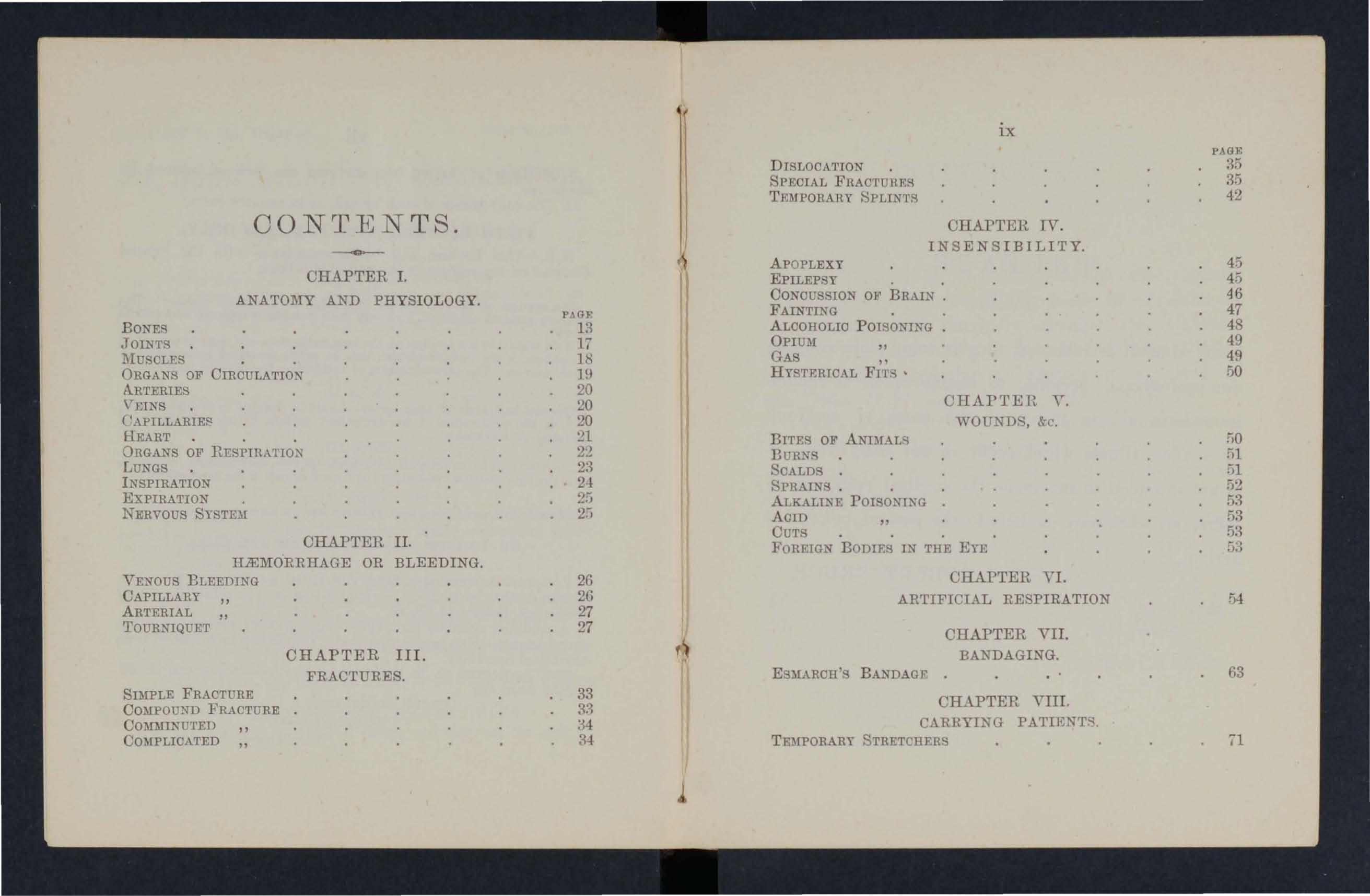
CHAPTER II. IIlEMORRHAGE OR BLEEDING.
VENOUS BLEEDING CAPILLARY ARTERIAL TOURNIQUET
SnIPLE FRACTURE
COMPOUND FRACTURE COMMINUTED COMPLICATED
CHAPTER III. FRACTURES.
DISLOOATION . FHACTUHES
TF.lIIPOHARY ApOPLEXY EPILEPSY
CHArTER IV. INSEN SIBILITY.
CONOUSSION OF BRAIN . FAINTING
ALCOHOLIC POISONING OPIUM
GAS " HYSTERTOAL FIT':! ' BITES OF BURNS • SOALDS • SPRAINS. . ALKALINE POISONING ACID CUTS "
CHAPTEn Y. WOUNDS, &c.
FOREIGN BODIES IN THE EYE
CHAPTER YI. ARTIFICIAL RESPIRATION
CHAPTER VII. BANDAGING. BANDAGE
CHAPTER VIII. CARRYING P ,,\.TIENT"l . TE)fPORARY
OONTENTS.
P ,\GF B 17 ]8 HI 20 !:!O 20 :n 2:{ 24 26 26 27 '27 33 'H I
ix
STRETCHERS PAGE R5 35 42 45 45 46 47 48 49 49 50 54 63
INTRODUCTION
TO ORIGINAL EDITION.
PREFACE.
THIS Manual is intended to give some plain rules to non-professional persons, to enable them to render inlmediate aid in many of the cases of accident or sudden illness which occur in our daily life. It is not intended to supersede the medical man, but to point out what may he done to the patient before his arrival.
CITY ROAD, October, 1887.

ROBERT BRUCE. )
AT the request of the Members of the Central Ambulance Committee of the Order of St. John of Jerusalem, I have hurriedly arranged the following Manual for the use of the Metropolitan Police and the other Am lmlance Classes now organised by the Order of St. John in all parts of England. The careful work which I should like to have bestowed has been rendered impossible by the exigencies of the Service requiring me to proceed on foreiQ"Il service.
I have been aided by kind and able coadjutors, who have given their knowledge and experience.
I trust that this Handbook, given cheerfully and gratuitously-likE' all the work conducted for and by the Order-will be found to be in some degree "PRO UTILITATE HOML: Ul\I."
JUNIOR UNITED ER''1CE CLUB, LONDON, .W., 30th Octobe1·, 1878 • P. SHEPHERD.

FIRS T AID TO THE INJUR ED. CHAPTER 1.
ANATOMY AND PHYSIOLOGY.
FOR ihe purpose of rlcscription, we may divide the body into the TI'l(,nk, comprising the thorax, or chest, and the ahdomen, or belly; the Heacl, comprising the br uiu -case, and fn Cf' ; the Upper Limbs, the arms; and the Lower Limbs, the legs. The framework upon which the Lody is built is called the skeleton (Fig. 1 ), formed of over 200 bones, which vary in size and shape according to BONES.
FIG. 2. the work they have to perforl1l .
------------------- ----
Besides forming a framework for the muscles, the bones form cases for the protection of the various oi'gans, and support the weight of the body.
The bOlles of the skull mtLy be divided illto those of the brain-case, eight in number, and those of the face, fourteen in number. With the exception of the lower jaw, they are all very firmly joined together, forming a strong case for the protectioll of the brain, ear, eye, nose, and tongue. The bOlles forming the top of the blain-case are thick and curveu, so thai the force of any blow falling Oll the top of the head may be broken.
The skull rests UpOll a column of bone called the vertebral column, or Spine, extending from the head to the haunch bones. This column is made up of thirty-three bones called the Vertebrce-the twenty-four upper called the true vertebl'ce, the nine lower the false. Betweell each of the true vertebral there is a pad of cartilage, or gristle, which acts as a buffer, and pre\ents the bones jarrillg when they move, and gives elasticity to the whole colulll1l. The bones are kept in their places by bands of a tough, strong substance called fibrous tissue, which passes in all directions around them. Although there is no movement between any two vertebral, the Sp .ne is a very flexible rod, and can be bent in every direction, the greatest amount of movement being in the neck and loin portions. The seven upper bones are called the Cervical, or neck vertebral, the next twelve the Dorsal, or back vertebral, and
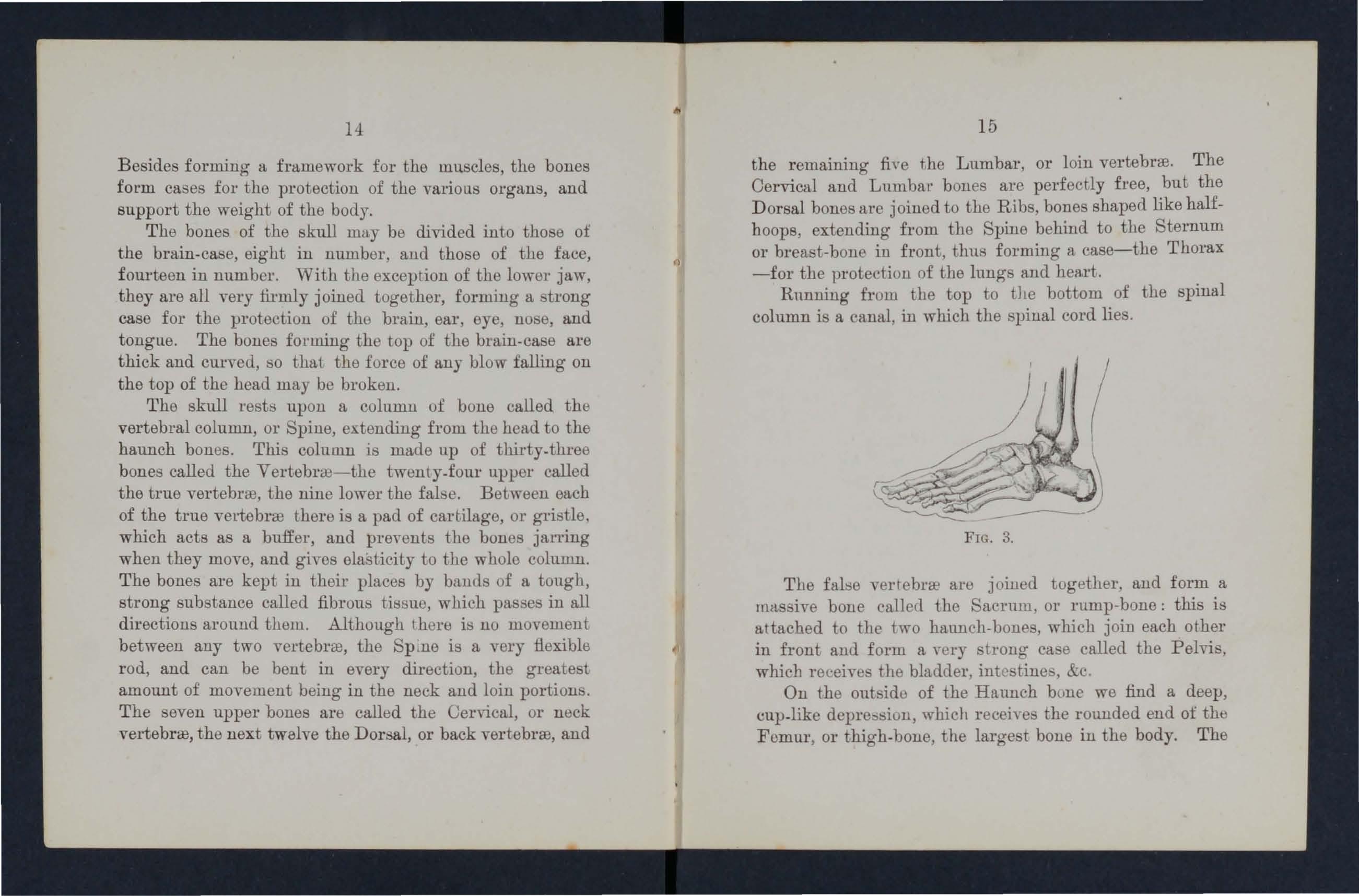
the remaining fhe the Lumbar, or loin vertebral. The Cervical and Lumbat' bones are perfectly free, but the Dorsal bones are joined to the Ribs, bones shaped like halfhoops, extending from the Spine behind to the Sternum or breast-bone in front, thus forming a case-the Thorax -for the protection of the lungs and heR,rt.
Rnnning frOID the top to the bottom of the spinal column is a canal, in which the spinal cord lies.
FIG. 3.
The fabe verrebrfe are joined together, and form a mas ive bone called the Sacrum, or rump-bone: this is attached to the two halillch-bones, which join each other in front anu form a yery strong ca e called the Pelvis, which receives the bladder, intestines, &c.
On the outside of the Haunch bune we find a deep, cup-like depre::,sion, which receiyes the rounded end of the Femur, or thigh-bone, the largest bone in the body. The
14
n 15
16 other enel of the femur rests upon the Tibia, or shin-bone, forming the Knee-joint., which is protected in front by a bone calleel t,he Patella, or knee-cap.
The leg has two bones in it: the inner one, the Tibia, is very strong anel thick, anel CUl'\Tes inwards; the outer, the Fibula, or broach-bone, is a thin one, which strengthens the leg without adding much to its weight. The lower ends of these bones, called the Ankle-bones, form an arch, which receives the upper part of one of the bones of the foot. In the foot there are twenty-six stout, thick bones, joined together very firmly, anel url'nnged in u double arch-one arch exton ding from the toos to the heel (Fig. 3), the other from side to side. This arrangement gives elasticity and strength to the foo.t, enabling us to move freely and easily. A person III whom these arches are not perfect is called flat-footeel.
All the bones in the lower limbs are strong and thick, as they have to support the whole weight of the body.
Extending between the top of the Breast-bone and the shoulder on each side is a flat double-curveel bone called the Clavicle, or collar-bone, which serves to keep the shoulders apart. The outer end, with a portion of the shoulder-blade, forms a hollow in which the upper end of the arm-bone is lodged.
The Scapnlre, or shoulder-blades, are large, flat, irregu. lar-shaped bones, which lie on the back of the Thorax, covering the seven upper ribs. They give additional

17
st.rongth to this case, and serve for the a..ttachment of muscles which lllOYO the upper limbs.
The bones ill the upper limb are long, thin, and light, as they have to I:iUpport no weight, but are rey'IDred merely to enable us to reach a long distanee, and in the hand to cover a largo l:ipace. They cOl'1'espond in number to those or the lower limb, but are arranged somewhat differently.
In the Arm, there is one bone-the Humerus; in the Fore·arID there are two-the Ulna on the inside anel the Radius on the outside. These join the Wrist, in which thore m·e eight small bones joined firmly to each other, and forming (1, very flexible joint.
In Lhe Hand there are nineteen long bones, fi, e beiug in the palm; the relllaining fomteen forming the fingers.
JOINTS.
When two 01' morE) bones COllle together, they form a joint; moclificntiolls or the "ball and socket" anu the .. hinge" beiug the mOtit comlllon kind'. The ends of the bunco forming the joints are larger than their middles or shafts; they are coated with layer of gristle or cartilage, which acts as a buffer, allll prevents pain beiug caused "hen the bones mo, e upon each other; o.er thIS cartIlage 18 a skin 01' mombnme, wlueh maketi an oily fluid, to lubl'lcate the parts and to enable them to mo.e freely. The bones are kept in position by a number of bands of fibrous tissne, which completely surround their ends. B
18 l\IUSCLES.
The bones are mo ed by the muscles, the masses of red flesh which mR.ke up the bulk of the body. These are arranged and shaped according to their work: where they
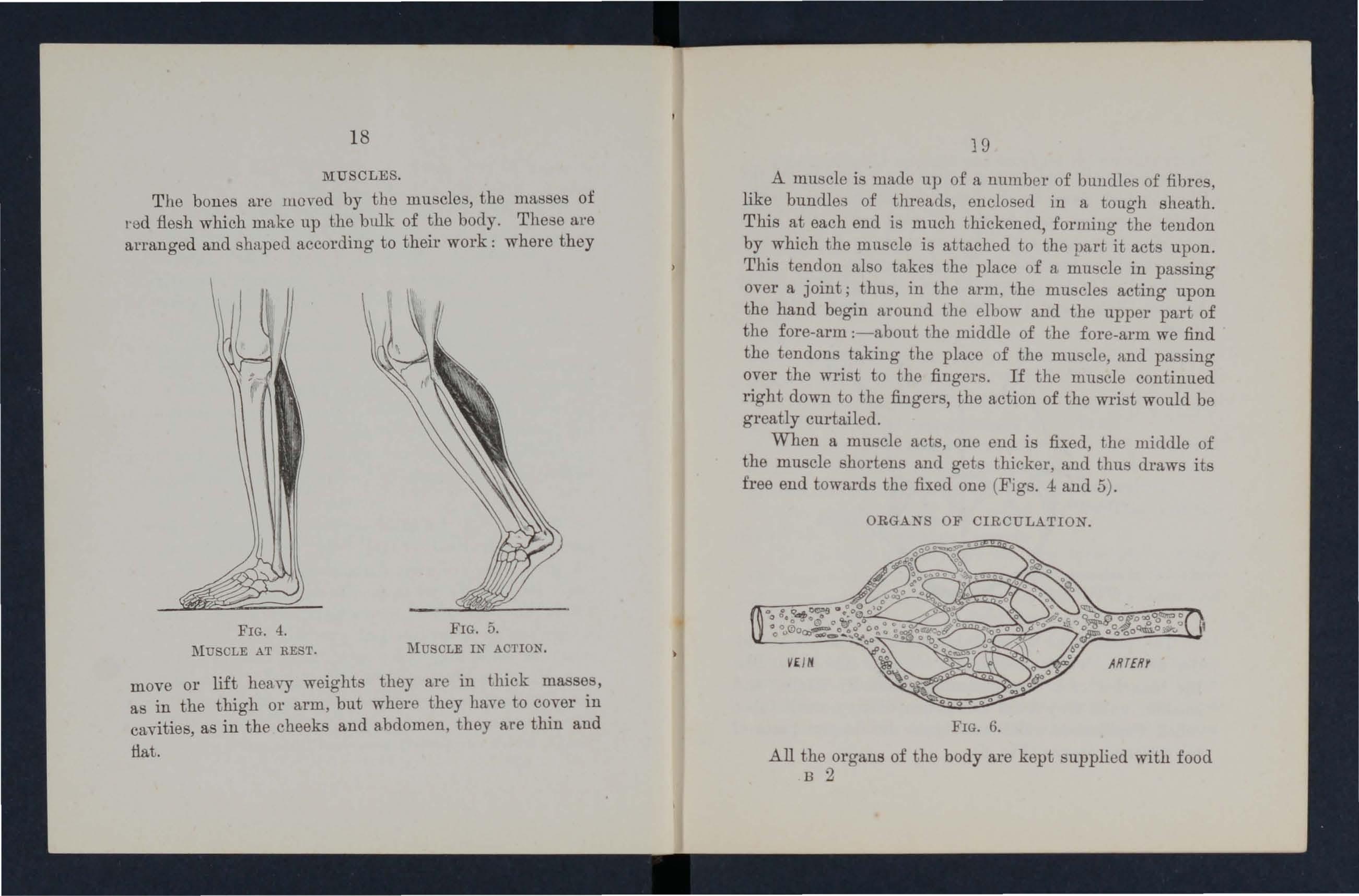
FIG. 4. MUSCLE AT REST.
FIG. 5. 1IusCLE IN AOTION.
move or lift heavy weights they are in thick masses, as in the thigh 01' arm, but where they haye to cover in cavities, as in the cheeks and abdomen, they are thin and fiat.
19
A muscle is made up of a number of bundles of fibres, like bundles of threads. enclosect in a tough sheath. This at each end is much thickened, forming the tendon by which the muscle is attached to the part it acts upon. This tendon also takes the place of a mu cle in passing over a joint; thus, in the arm, the muscle acting upon the hand begin around the elbow and the upper part of the fore-arm :-abont the middle of the fore-arm we find the tendons taking the place of the mu cle, and passing over the wl'ist to the fingers. If the muscle continued right down to the fingers, the action of the wrist would be greatly curtailed.
When a mu cle arts, one end is fixed, the middle of the muscle shortens and get thicker, and thus draws its free end toward the fixed one (Figs. -* and 5).
ORGANS OF CIRCULATION.
FIG. 6.
All the organs of the body are kept supplied with food B 2
__ ... 1.1 •••....... JII ••. " .. ,.. ;. • . -r..· .. ;:h ..... I . . ," . ...... "': ' : ........
:W for their growth and propel' action by tL fiuicl calloel. the Blood, which flows in all directious through the body. Besiel.es carrying fooel. to t.110 cli:iIel'eut t.he blood as a scavenger and takes away lrom them matter which would be harmful if allowed to l'ellltLiu.
The blood is driyen oyer the body throngh tubes culled Arteries, Veins, and Capillaries, hy an organ called the Heart.

FIG. 7.
The pure blood is carried away frum the Heart. by the arteries, which branch out all oyer the body, like the branches of a tree, becoming gtaduaJJy smaller and smaller, until they form a network of very small tubes callod Capillaries, which enter into the deepest parts of the different orgaus (Fig. 6). 21
The capillaries re-unite and run into the smaller veins j these gradually rejoin, and form larger ones which convey the blood back to the heart. When the blood reaches the veins it is in an impure condition, as while it is passing through the capillaries it gives up its good qualities, and picks up any waste material which may be there.
The Heart a hollow muscular organ of a conical shape, which lies in the middle of the chest, behind the breast-bone, chiefly on the left side. The base looks upwards, and the point extends to just below the left nipple, where it can be felt heating.
The accompanying diagmm (Fig. 7) will give a rough idea of the internal arrangements of the head.
Running' from the base to the apex is a partition (li \ricling the interior into two portions: these are sub· di\Tided into two others by means of flnps or valves.
The uppor cavitjes are called the Auricles, and the lower the Ventricles.
In the right auricle there !tl'C two openings, by which the impure blood entors-by the upper one from the veins ot the head amI upper extremities, and by the lower one fl'om those of the hlWer parts of the body.
As soon as tho al1l'icle is fnll of blood, its walls close and force the blood through the valve into the ventricle. -YVhen this is fnll, its walls closo and force the blood tlnough the pulmonary artery into the lung. . The blood returns from the lungs tlu'ough the pulmonary veins
into the left auricle i from this it passes into the left ventricle, which forces it into the Aorta, the large artery which begins at the back of the left ventricle, and through this it passes into the maller arteries, which convey it over the whole body .
The left ventricle has the thickest and strongest walls of any of the cavities of the heart, as it has to drive the blood over the whole body.
The blood is prevented from returning into the auriclE'S from the ventricles by valves which are attached to the sides of the walls of the heart i the free edges of tlle valves are attached to the walls of the ventricle by strong threads ()f fibrous t,issne, which are only just long enough to anow them to meet, and so to shut off the two cayities.
Both auricles act together, and then the ventricles, causing the double sound that is heard over the region of the heart. The pnlsation which is felt in the arteries is caused by the adion of the ventricle, (hiving a fresh supply of blood against that which is already in the Aorta: the pulsation is only felt in the arteries, as the blood loses its force while passing through the capillaries i when it reaches the veins it flows in a steady stream.
The blood in the arteries and on the left side of the heart is always pure, while on the right side and in the veins it is impure.
ORGANS OF RESPIRATION
One of the chief impurities taken up by the blood in 23
its passage r ound the body is a gas called Carbonic Acid .
If this be allowed to remain in the blood, it will soon cause suffocation. To get rid of it, the blood
t.he l ungs. The process by which this punficabon I S

FIG. 8.
completed is called respiration, ana is divided into two stage -viz., illspiration awl expiration.
The Lungs (Fig. 8) are two large bodies, which, with the heart, fill the cavity of the thorax, or chest. They
22
rest upon an arched muscle called the Diaphragm, or midriff, which divides the thorax from the abdomen.
The lungs are made by the division of the Trachea, or wind-pipe. This flexible pipe nms down the front of the neck from the root of the tongue to the top of the breast-bone, where it divides into two branches, one running to the right, the other to the left; these again divide
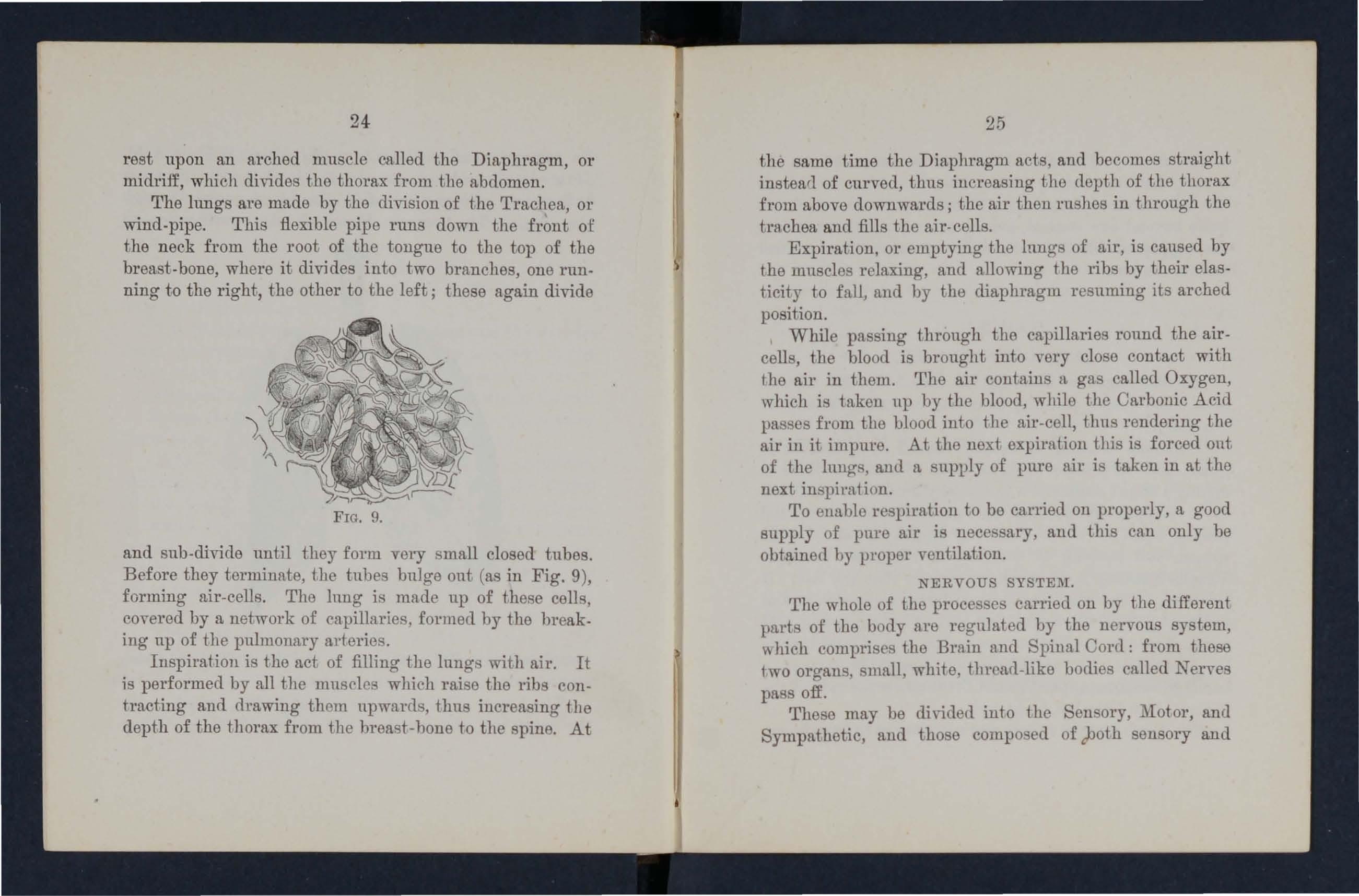
FIG. 9.
and sub-divide until they form very small closed tubes. Before they terminate, the tubes buJge out (as in Fig. 9), forming air-cells. The hmg is made up of these cells, covered by a network of capillaries, formed by the hreaking up of the pulmonary arteries.
Inspiration is the act of filling the lungs with air. It is performed by all the mnscles which raise the ribs contracting ann. drawing them upwards, thus increasing the depth of the thorax from the breast-hone to the spine. At
the same time the Diaphragm acts, and becomes straight instead of curved, thus increasing the depth of the thorax from above downwards j the air then rushes in through the trachea and fills the air-cells.
Expiration, or emptying the lungs of air, is caused by the muscles relaxing, and allowing the ribs by their elasticity to fall, and by the diaphragm resuming its arched position.
While passing through the capillaries round the aircells, the blood is brought into very close contact with the air in them. The air contains a gas called Oxygen, wInch is taken lip by the blood, wllile the Carbonic Acid passes from the blood into the air-cell, thus rendering the ail' in it impure. At tbe next expiration this is forced out of the h1llg"R, and a sUPllly of pme air is taken in at the next inspiration.
To 8uuble respiration to be carried on properly, a good supply of pure air is necessary, and this can only be obtained hy propel' ventilation.
NERVOUS SYSTEM.
The whole of tbe processes carriell on by the different parts of the body are regnlated by the nervons system, \-\ hich comprises the Brain anel Spinal Oord: from these 1wo organs, small, white, thl'eacl-like boc1ies called Nerves paBs off.
These may be div-ielerl into the Sen ory, Motor, and Sympathetic, and those composed of )loth sensory anel
24
25
m otor fibres. The first kind convey sensation to the brain; the second carry orders from the brain and cause the different muscles to act. The Sympathetic, which are quite beyond our control, among other functions, regulate the supply of blood to the different organs, and control certain muscles.
CHAPTER II.
HlEMORRHAGE.
Hffimorrhage, 01' bleeding, is caused by the rupture of a blood-vessel, and may he either Arterial, Venous, or Capillary.
Capillary bleeding is usually caused by a scratch or grall,e, and very little blood is lost. Sometimes there is merely a slight oozing of a red., sticky fluid. from the place. It is stopped by bathing the part in cold. water, and placing a pad of lint, 01' lilien rag dipped in water, on the wound, and keeping it there by a triangular bandage. Venous bleeding is of more importance than the last. It is known by the blood being of a dark purple colour, and welling up from the wound.. A pall of lint dipped in cold water should be applied at once to the wound, and tied on by a bandage; but if this is not enough to stop it, a bandage must be applied round the limb \'11 the side of the wound away from the heart.
The Limb must be raised, and not allowed to hang down.

A very serious ca e of venous bleeding occms when a varicose vein in the leg bursts, and. this must be treated as above, the patient being placed on a sofa or bed. with the leg raised.
In bleeding from the nose, the pa tient should be placed on a chair or sofa, with the head raised, and ice or cold water applied to the forehead and nose.
Arterial bleeding is the most important, because, nnless it is soon stopped, the patient may bleed to death, as the blood always escapes with great force. It is of a bright reel colom, and spurts up frolll the wound with a jerky jet.
To stop it, pressure must be applied. at once to the wound, and if the bleeding continue, the main artery npplying blood to the part must be compre sed.. This must be done in Borne part of its course where it passes oy('r 11 bone, and as Ileal' the wound as possible. '£he pressure should not be enough to cause the patient severe pain, but jUl:lt sulficieut to stup the ::;trealll of blood.
Pressure may be applied either by the fingers or by a tourniquet, a very mmfnl form of which may be made by tying a knot in the miclllle of a triangular bandage, thus (Fig. 10) :-
FIG. 10.
The knot is placed on the artery, and the ends are tied
26
27
28
round the limb to keep it in its place. 1£ a thin handkerchief 01' piece of cloth be used, somethillO' solid should be placed inside the knot. If the pressure be not enough to the pass It stick under the bandage and tWlst It round till the pressure is enough. An elastic bandage, or. piece of india-rubber tubing, applied tightly round the hmb, makes a useful tourniquet.
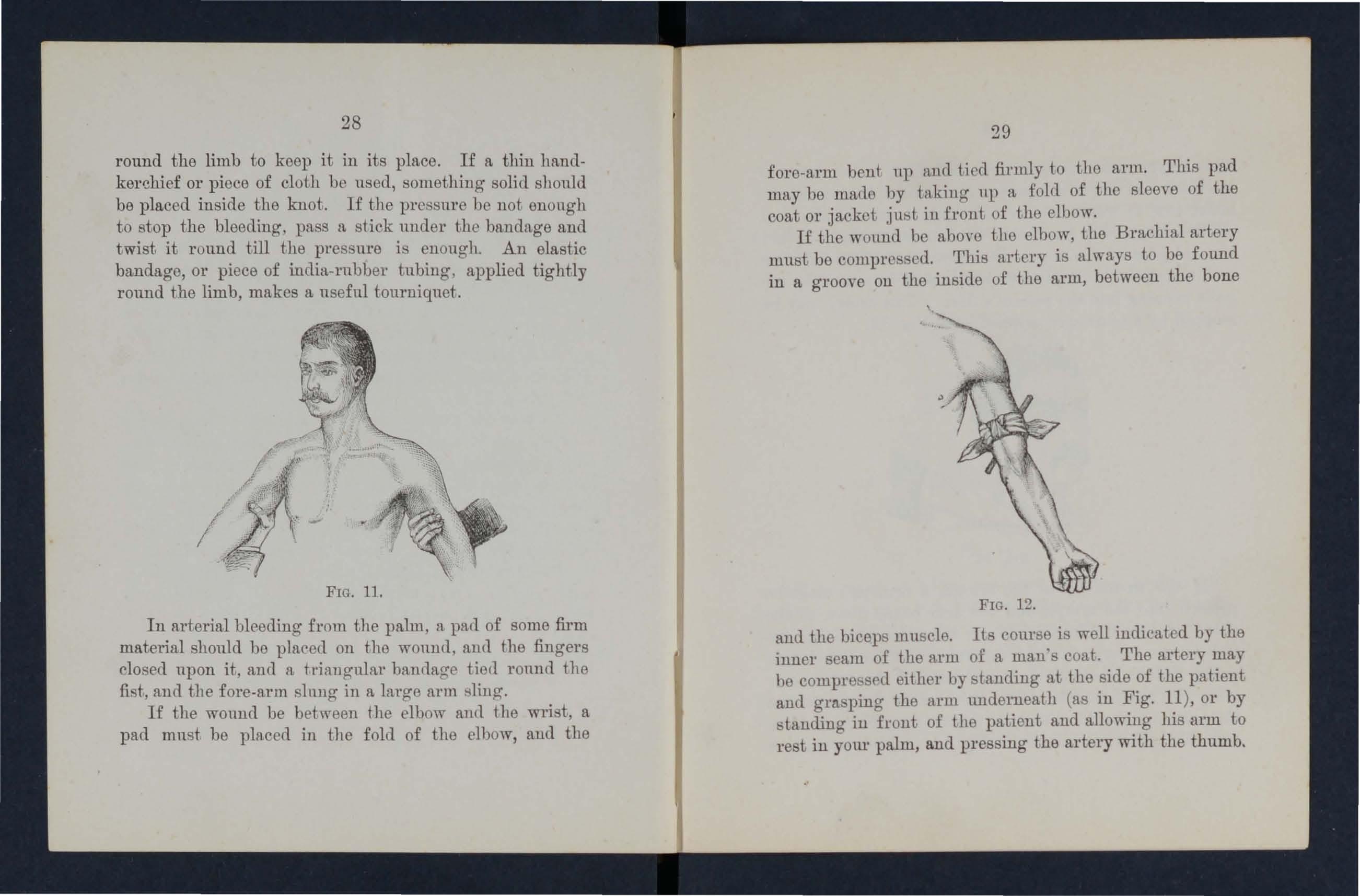
11.
In Ilrterial bleeding from the palm, a pad of some firm material should be placed on the wonnd, and the fingers closed upon it, and a tl'iungulltl' banclage tied roullfl the fist, and the fore-ann sllUlg in a In,l'ge arm filing'.
If the wound be between the elbow and the wrist, a pad must be placed in the fold of the elbow, aud the
29
fore-arm bent lip tied firmly to tllO ann. This pad may be made hy taking lip a fold of the sleeve of the coat or jackcL jlll:it in frout of the elbow.
If the wound be aboye the elbow, ihe Brachial artery must be compressed. This artery is always to be found in a groove on the inside of the arm, between the bone
12.
amI the biceps muscle. Its conroe is well indicated by the illller seam of the arill of a man's eoat. The artery may he comlJl8ssrd either by stancling at the bide of the patient and grasping the arill undel'1leath (as in Fig. 11), or by otauding in fl'ont of the patient and allowing his arm to rest in yom palm, and pressing the artery with the thumb.
FIG.
FIG.
This artery must always be pressed from above down to the bone, and never be grasped from above, because in the latter case it would pressed against soft muscle, and the would continue. Oare must be taken to place the end Jomt of the fingers on tho artery; if the extreme end of fingers be used, severe pain will be cau ed by the nails running into the patient's flesh. This artery may be stopped by a tourniquet applied as in Fig. 12.
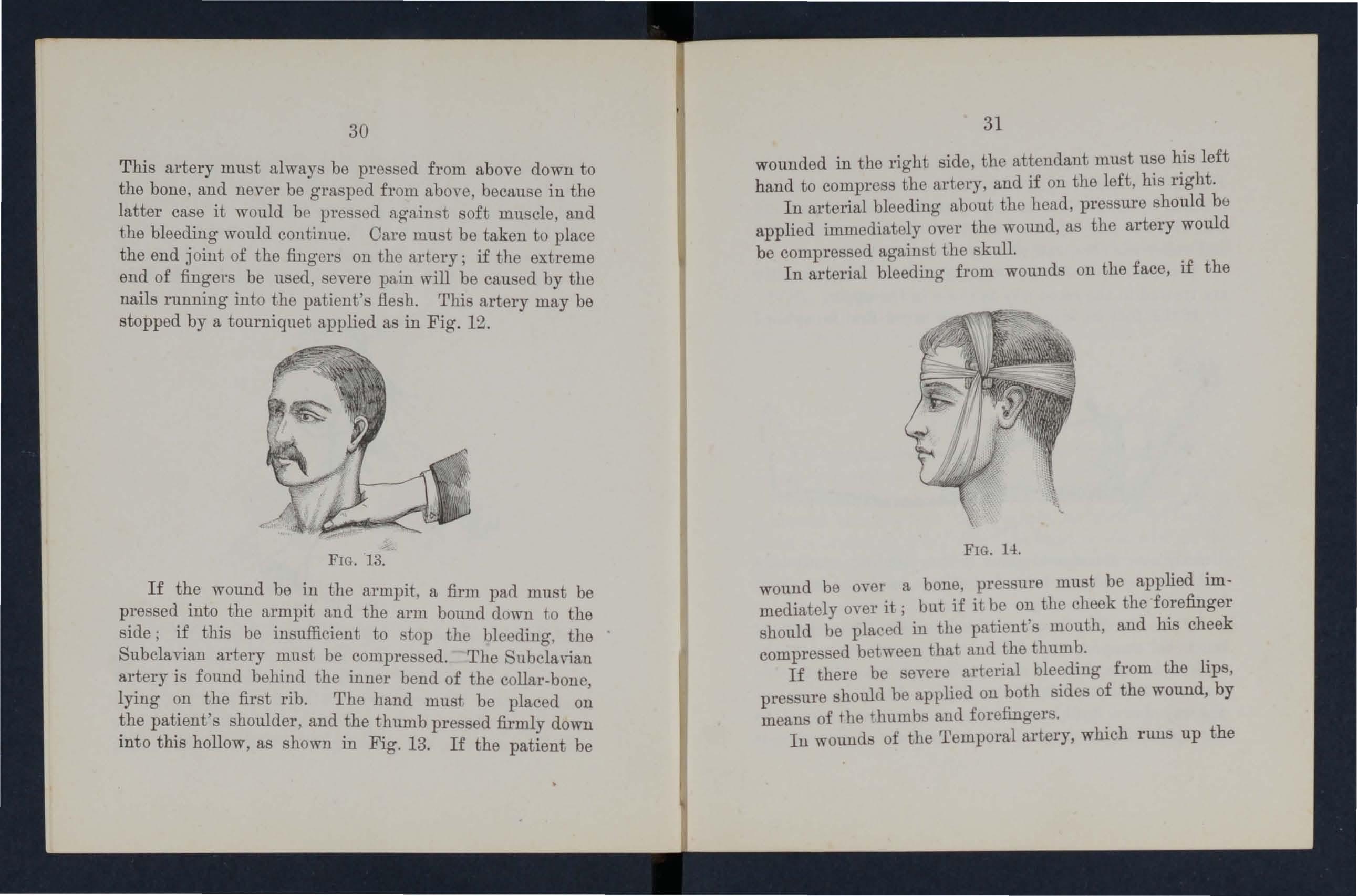
FIG. 13.
If the wound be in the armpit, a firm pad must be pressed into the armpit and the arm bound down to the side; if this be insufficient to stop the bleedillO' the Subclavian artery must be compressed. The artery is found behind the inner bend of the collar-bone lying on the first rib. The hand must be placed shoulder, and the thumb pressed firmly down mto thIS hollow, as shown in Fig. 13 . If the patient be 31
wounded in tho right side, the attendant must use his left hand to compress the artery, and if on the left, his right.
In arterial bleeding about the head, pressure should be applied immediately over the wound, as the artery would be compres ed against the skull.
In arterial bleeding from wounds on the face, if the
FIG. 1-:1:.
wound be over a bone, pressure must be applied illmediately over it; but if it be on the cheek the forefinger should be placed in the patient's mouth, and his cheek compressed between that and the thumb.
If there be severe arterial bleeding from the lips, pressure should be applied on both ides of the wound, by mean of j he thumbti and forefingers.
In wounds of the Temporal artery, which runs up the
30
32 side of the forebead, a compress may be applied, as in Fig. 14. A pad is plclced upon the wouud, and kept in position by means of a bandage passed rOlUld the head and tied over the pad; the ends are then carried over the head and under the chin, and tied again over the pad.
WOlmds, with arterial bleeding, iu the lower extremity are treated in the same way as those in the upper.
If the foot be injured, pressme must first be applied

FIG. Hi.
directly over the wound; and if the bleeuiug continuo, a pad must be placed behinu the kuee, and the leg beut back and tied to the tillgh.
If the bleeding be .above the knee, the Femoral artery must be compressed. Tills artery commences at the middle of the fold of the groin, and runs dOWllwards towards the inner side of the thigh. About one-third of the way down it dips lmder the mnscles, and cannot be felt again till it comes behind the knee. Pressure io
33
applieu either by p1acing the thumb in the groin and pressing the artery against the front OT the haunch bone (Fig. 15), or by a knottecl triangular bandage or a tourniquet applied tightly over 1110 art cry lower down the limb (Fig. 15).
The plan of tryillg to stop bleeding with tobacco must never be used, as there is great danger of the patient becoming poisoned.
As soon as tho stream of blood has been stopped, the wound must be troated as an ordinary wOlmd.
OIIAPTER III.
FRAOTURES.
A bone may be broken either by direct violence, by which is meant a blow falling directly on to the bone, or by indirect violence, where the bone is broken by being squeezed betwcen two fixed points, as when the collarbone is broken by a fall upon the hand or shoulder, or the ribs broken by the patient being crushed in a crowd, or between a cart and a wall.
Tbere are foUl' kinds of fraciureR :-
SIMPLE :-Wherc the bone only is broken.
OOMPOUND:- "Where the bone is broken and a wound through tho skin leads down to it broken ends. This wound may be cmu;cu either by the injury which can ed the fracture, or hy tho broken bono being driven tlu'ongh the skin by improper handling of the part after the c
accideJlt, such as placing a person with a fractured thigh in a cab or carriage before applying splints.
COMMINUTED :-Where the bone is broken in more than one place.
COMPLICATED :-Where the bone is broken and some of the surrounding parts injured, as when the ribs are driven into the lungs or liver, 01' the femoral artery or vein pierced by the broken thigh-bone.
Before attempting to move a patient from the place of accident the part must be secured by something firm which will prevent the broken bone from moving.
Signs oj F1'act'l.M'e.
1. There is loss of power in the limb or part.
2, There are pain and swelling at the seat of the injtu'Y.
3. If the injured limb be compared with the sound one, some distortion will be noticed, it being either longer or shorter. or lying in some unnatural position.
4. If the limb be gently pulled it will regain its natural shape, but will return to the di torted position as soon as the traction ceases.
5. If tho limb be gently moved it will be foulld to move sOlllewhere in the shaft of the bone, instead of at the joint only; at the same time, a grating sensation (c1'epitus) may be felt.
6. If the bone be near the skin, some irregularity will be felt in passing the finger along it.
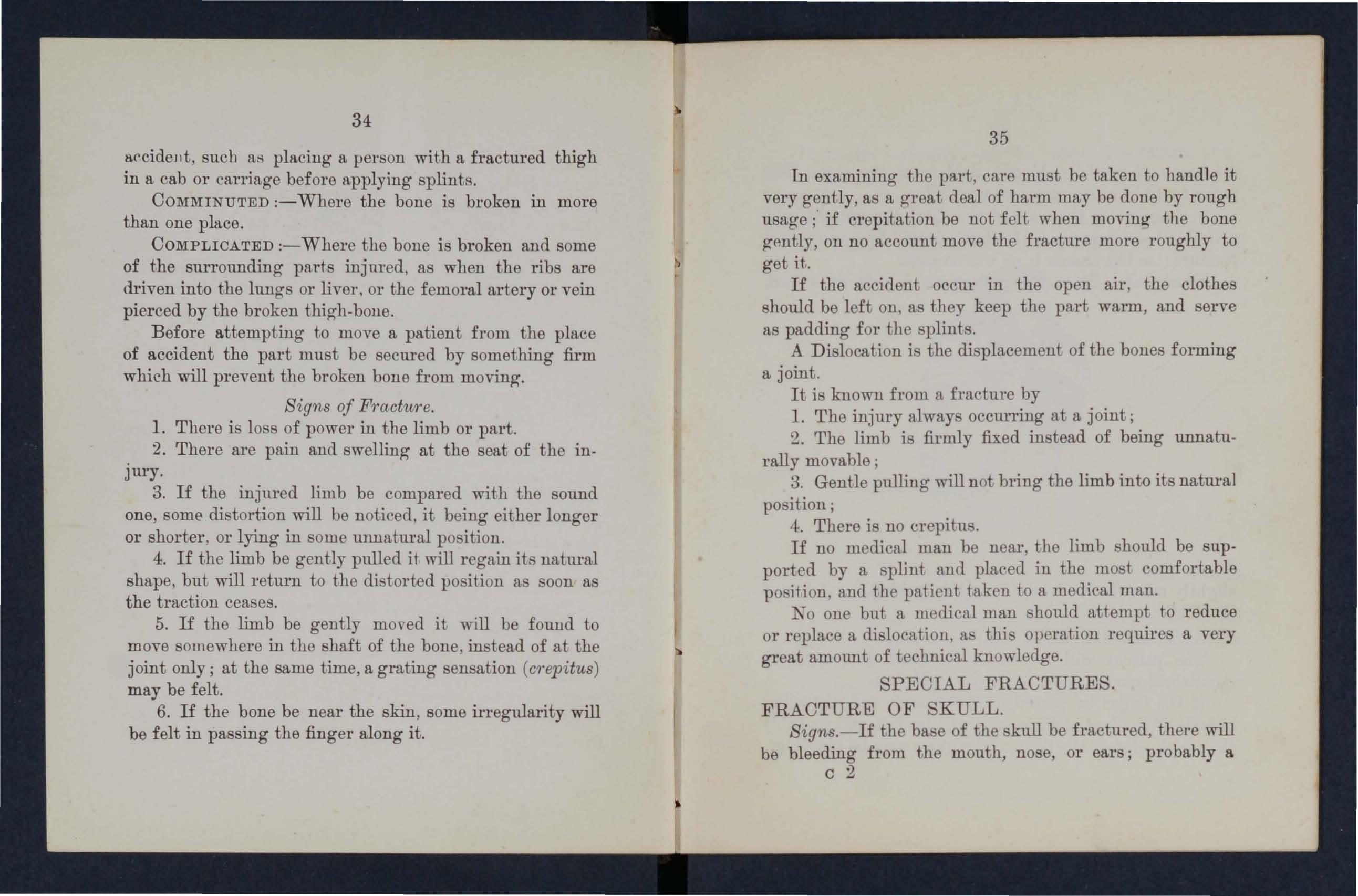
In examining tho pa.rt, care must be taken to handle it very gently, as a great deal of harm may be done by rough usage; if crepitation be not felt when moving the bone g"Antly, on no account move the fracture more roughly to get it,.
If the accident OCClU in the open air, the clothes should be left on, as they keep the part warm, and serve as padding for the splints.
A Dislocation is the di placement of the bones forming a joint.
It is known from a fracture by
1. The injury always occurring at a joint;
2. The limb is firmly fixed instead of being unnaturally movable;
3. Gentle pulling will not bring the limb into its natUl'al position;
4. There is no crepitus.
If no medical man be neal', the limb should be supported by a splint and placed in the most comfortable po ition, and the pnticut iakell to a medical man.
No one but a medical man should attempt to reduce or replace a dislocation, It this operation requires a very great amount of technical knowledge.
SPEOIAL FRACTURES.
FRACTUR-@ OF SKULL.
Signs.-If the ba e of the kull be fractured, there will be bleeding from the mouth, nose, or ear ; probably a C 2
34
35
discharge of a sticky, bloody fluid from the ears. The patient will be quite Llllconscious.
In fracture of the roof of the skull the patient will probably be unconsciolls. Probably it will be a compound fractme j so the broken bO:Q.e will be seen.
T1·eatment.-Place the patient on a sofa or a bed,
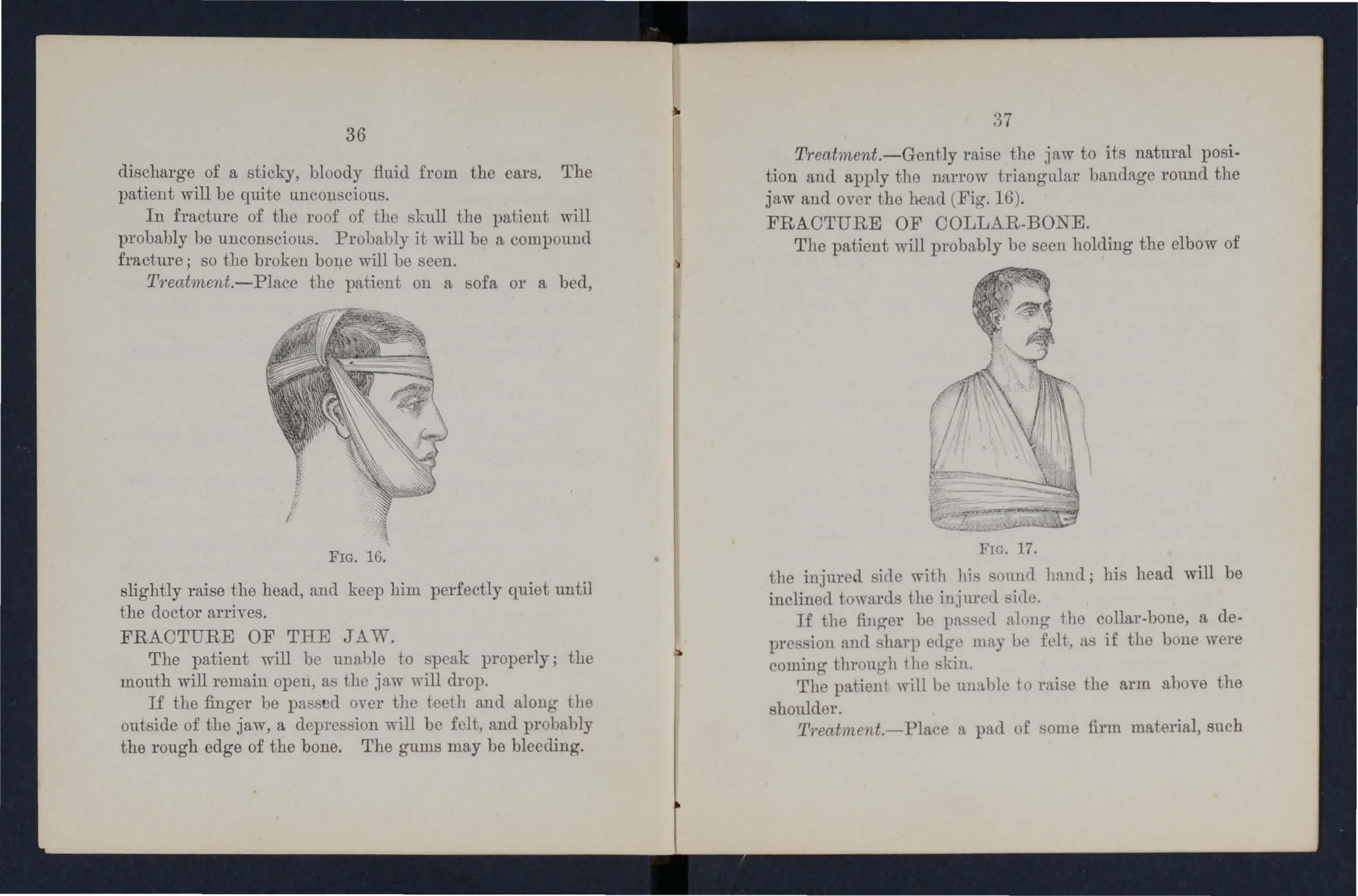
FIG. 16.
slightly raise the head, and keep him perfectly quiet lmtil the doctor arrives.
FRAOTURE OF THE JAW.
The patient will be unable to speak properly j the mouth will remain open, as the jaw will drop.
If the finger be passed over the toeth and aloug the outside of the jaw, a depression will be felt, and probably the rough edge of the bone. The gums may be bleeding. ;)7
l1reat?nent.-Gent,ly raise the jaw to its natural position and apply the narrow trianglllar bandage round the jaw aud over the hostd (Fig. 16).
FRAOTURE OF OOLLAR-BONE.
The patient will probably be seeu holding the elbow of
FIG. 17.
the injnrNl side with hi . S01111cl haml his head will be inclined towards the injure(l sille.
If the fiJlger be pnssc(l along the collar-bone, a depres ion mHl sharp o(lgo lllny be felt, as if the bOlle were cominO' through tho skin.
The patient will he ull,thle to raise the arJll above the shoulder.
Treatment.-Place !1 pad of so me firm material, such
36
38
as a triangular bandage or handkerchief rolled tightly, in the arm-pit; raise the arm gently, and sling it with the large arm sling, then tie the arm to the side by a broad passing round the al'm and chest outside the slillg, and tIe to the side with a narrow bandage.
The bandage billlling the arm to Ule side must alway be placed as ncar the elbow a pos ible, as the arm is to act as a level' to draw out the outside piece of the fractured bone (Fig. 17).
FRACTURE OF THE ARM-BONE.
Signs.-The usual signs of a fracture.
:.llreat?11,ent.-This fracture may be put up in two, three, or four splints; these must be placedIf two be used, one inside the arm and the second ontside;
If three, one inside, one outside, and one at the back; If four, one inside, one outside, one ill front, and one at the. back. The splints must be kept in position by two trIangular bandages-one tied on each side of the fracture.
The arm must then be slung in the small arm-sling. Straw envelopes of bottles, or the wooden flower-pot ornaments, may be used for this fracture as they can be easily adapted to the part. '
FRACTURE OF THE FORE-ARM.
Signs.-If both bones be broken, the usual signs of

39
fracture will be present; but if only oue be broken, the SigllH will be lo-;s of power in the limb, a depression felt at the seat of fmctllre, great pain at the same point.
The treatment is the same in either ea e.
T1-eatment. - Bond the fore-arm, keeping the thumb upwards; then apply two splints, oue on the inside or front of the fore-arm, the other on the outside or back. The inner one should extend from the bend of the elbow to the palm; the outer should extend from outside the elbow to below the wrist. Tie the splints to. the arm by a bannage on each side of the fracture, then sling the fore-arID in a large sling.
FRACTURE OF FINGERS.
Signs.-The usual signs of fracture.
T1-eatment.-Place the whole hand on a broad splint, well padued with some soft material; keep it in position with the triangnlar hand-bandage and sling the arm in a large sling.
FRACTURE OF RIBS.
Signs.-Patient will complain of a sharp cutting pain on taking a deep breath or coughing j he will keep his hand firmly pressed on the injured part to prevent the sicle mOTIng; he will breathe in a short, jerky manner. If the hand be placed over the seat of the pain, a grating may be felt when the patient breathes; the ends of the broken bones may be felt.
40
1? ·eatment . - T ie two brond triangular bandages firmly r ound the chost, making tho lower part of one and the upper part of the other COVOl' the seat of pail).
FRAC TURE OF THE THIGH.
Signs .-Usual signs of fracture.
T?·eat?ncnt.-Place a long splint on the outside of the body, oxtendiug from the arm-pit to the foot. This lllU t be tied firmly to the body by a bandage passing round the chest; round the hips; one above and one bolow

clown the leg; 01' j he pntient may he (ied on to a shutter. or a l ong piece of wood, oither of which mnst be carefully pushed under the two thighs and tioll to them by bandages. Or if notrung suitable for a splint be at hand, tie the two legs firmly together.
A useful splint for the thigh or leg may be made by rolling a pole in a piece of cloth or flannel, the free end
FIG. 18.
the fracture; one or two below the knees; and the legs must then be firmly tied togother (Fig. 18). The nppel' bandage mnst be placed round tho 11atient's chest, foJ' if tied ovor bis stomach it may causo him to bo sick, anll it will not keep the spliut finl1.
For this fractme any of the followiug tliings WIll as splints :-Bl'oom-handlo, two billiard cneR. the top (If 011(' being' tied to the handle of the ot.her; lmy IOllg', strong strip of wood. A rifle makes a good splillt. the hutt cud being placed under tho arm., and tIle lml'l'el ext udillg
of the cloth is passed nudor the limb, a,ml the polo is pla('ed ('lose up to it. mlll the limb t,JlCll co\'('re(l wit h the cloth; handages aro thon a,pplio<l to keep the polE' in position.
The slee, e of a, ('oat may he llll'llcc1 inside-out an(l filled with paper, straw, 01' anything firm, aJl,l the coat applied in the sallle way as the cloth and pole (Fig. 19).
For ('11i1cl1'en, walking-sticks auel n111111'el1l1.. are useful.
• 41
FlG.19.
4:2
FRAOTURE OF THE L
Signs.-If both bones be brokell, the llsual signs of fracture will be found; if the shin-bone only be broken, the fractme will easily be detected by passing the hand geutly down the leg, when the rough ends of the bone will be felt.
1£ the broach-bone only be brok en, there will be inability to use the limb, and great pain and swelling. Treat either case in the same way.
T?-eat1n ent.-Applyone splint on the outside of the leg, and another on the illsido; tie them firmly to the limb, and then tie the legs together (Fig. 20 ).

FIG. 20.
FRAOTURE OF KNEE-OAP.
Signs.-Broken bone wil1 be felt und er skin. Patient will be unable to move leg, which will be quite stiff.
T1-eatment.-Tie the leg on a splint extending from the buttocks to the heeL
For trellting a fracture, almost any substancfl which is t-trong enough to keep the limbs at rest may be used for temporary splints. Some of the following articles can
almost always be obtained, and can be easily adapted, viz. : a and scabhard, soldier's knapRack, policeman's truncheon and cape, a stocking filled with earth (Fig. 21), sand , mos s, 1m)" cbaff, or pap er, and ti ed just above the nnkle and at the t op; pie co8 of wood, hammer. , rulers,
21.
rolls of paper or newspap ers, straw casos of wine bottles, expanding ornaments for flower-pots, long thin book, strips of cardboard, walking- sti cks and umbrellas. If any hard sub tance b e used , care mu t be taken to pad it witb some s oft material, especially if it bas to be kept on the limb for some time.
=-=-!;...".,
43
FIG.
44
T he sp lints must be secm'ely fastened to the l imb by bandages placell on oither side of tho fracture j the splints should, where possible, enclose the joints on both sides of the fracture .
If no triangllhr bandages be at hand tho splints can be secmed by handkerchiefs, neckties, boot-laces, string, strips of cloth or calico, straps, &c. In all cases the limb must be placed in as natural a position as possible before the splints are applied.
If it is not necessary to move the patient from the place of accident: make him as comfortable as possible with pillows, &c., until the arrival of a medical man.
In fractmes complicateLl with arterial or yenons bleeding, the blood must first be stopped and the fracture then attended to.
CHAPTER IV.
INS ENS I B I LIT Y.
A very common symptom of sUllden illness or acciuont is insensibility, which may be prodncecl by the action of the brain or heart being interfel'etl with, oither by some injury destroying, or by a shock stopping, their action for a short time.
It is necessary to try and find out the cause of tho insensibility before trying to restore the patient.
The first thing to do to an insensible person is to loosen

45
the clothes round tho throat and chost, l)articularly any belts or braces; then pass tho hand quickly over the body, boginning aL ihe head, to find if thero bc any fracture, or wOlwd from which b]oou is flowing. If either of these injuries bo fOlllld, it must be attended to at once j but if llot, the patient must be carofully carriod into a houso and placed upon a beel or sofa, and kept perfectly quiet, with heael rathcr low. It is not always oasy to discover the cause of insellsibilit,v j so, in all cases of doubt the patient must be kept yery quiet till the arrival of the medical man.
APOPLEXY.
Signs.-Patient becomes suddenly insensible, breathing very labolll'f'd, and accompanied by a snoring noise j one cheek is puffed out with each expiration.
If the a1'111S bo raised, one will give some evidence of feeling, while tho other will fall helplessly to the side.
The patient C:1llll0t be roused.
Treatment.-Place the patient on a bod or sofa, with t he slightly raised. Loosen clothing round neck. Apply hot bottles or flannels to the feet and legs, and cold applicatiolls to head.
Do not attempt to give any stinmlants, elnetics, or anything by the mouth.
EPILEPS Y, OR FALLING SICKJ\"ESS.
Signs .-Thc patient is suddeuly seized with the fit,
46
frequently uttering a piercing scream before becoming unconscious, and falls down.
The hands are tightly clenched, the legs and arms being jerked violently towards the body.
The face becomes livid, and a froth, sometimes streaked with blood, appears round the mouth.
After a few minutes the convulsions cease, and the patient either gets up and walks away, or drops off into a deep sleep.
T?'eat?nent.-Place a piece of wood between the patient's teeth to preyent his biting his tongue.
If a pillow or hassock cannot be obtained, roll up a coat or shawl and place it under his head,
N eyer attempt to hold the patient firmly to the ground, but use just sufficient force to prevent him injuring himself.
If he wish to go to sleep after the fit, do not prevent him,
OONOUSSION OF THE BRAIN.
Produced by blows on the head, or from falling on the feet from a great height. It is either scvere or slight.
SLIGHT OONOUSSION.
Signs.-Patient will be very pale, breathing very slowly, lying with the eyes shut.
If spoken to, will rouse himself as if from sleep and answer properly; then will relapse into the partially insensible state,

47
After a few miuutes he will probably vomit, and then gradually recover.
7lreatment.-Place the patient on a sofa; apply warm bottles and flannels to his feet and hauds. As soon as he is able to drink, give him a cup of warm tea or coffee.
One form of concussion freqneutly met with occurs in young childreu. While playing about, they tumble and strike the head.
Most of the symptoms mentioncd abovc then appeal'.
The best thing to do in this case is to keep the child very quiet, and allow him to go to sleep, and not to rouse him, as mauy parents try to do.
SEVERE OASES.-In these the substance of the brain is tOl'll, and thc symptoms are like those of apoplexy, and the case must be treated as such.
FAINTING is due to the failure of the heart's action, and is usually caused by fright, hunger, heat, excessive fatigue, hromorl'hage, &c.
Signs.-The patient uddenly becomes pale; if standing, he staggers: if 8i tting Ilown, he is restlcs ' anu Ulleasy for a minute or two; a clammy sweat Ll'caks out over the forehead and under the eyes; the re piration becomes hurried and hallow, a,ud he then 10 es con ciousness.
7lreatment.-li occurring in a church or crowded room, the patient's head should be pres ed down below his knees and kept there for a few minute. After this he is usually sufficiently recovered to walk out of the room.
48
The clothes round the neck and chest should then be undone, and the face and hands bathed in cold water. A stimulant-as sal-volatile, toa, coffee, or wine-may then be given . Anothcr plan is to place the patient fiat on the floor with the head on a level with the body.
If the fainting be due to the loss of blood, the wound from which the blood is coming must be dressed, and the blood stopped, and some stimulant given.
Ii due to hunger or excessive fatigue, care must be taken not to give too much food at once. Some warm milk, beef tea, wine and water, may be giyen in small quantities very frequently; and as soon as the patient feels able to sit up and eat, something solid may be given.
ALOOHOLIO POISONING (DRUNKENNESS).
Signs.-Patient is helpless, both sides being equally useless; face usually flushed; pupils usually dilated, but sometimes contracted.
Ii the patient be questioned, he will answer in an in. coherent manner. There is usually a strong odour of alcohol about breath.
T?·eatment.-I£ told that the patient has been drinking very freely within a few hours, give an of a tablespoonful of salt in a tumbler of warm water, or one table. spoonful of mustard in the same quantity of warm water. Unless 'Pe?feclly s'U?'e that the 'Patient is mtoxicaied, do not give the mnetic. After this has operated, the patient may be allowed to go to sleep.

49
If the weather be very cold, care must be taken to keep the patient warm, as a drunken person is very susceptible to cold.
1£ the drinking bout has been a prolonged one, the patient must be kept quiet and warm till the arrival of a doctor. A cup of hot tea or coffee is the best stimulant to give the patient.
OPIUM (LAUDANUM) POISONING.
Signs.-Before the opium has taken full effect the face may have a flushed appearance; breathing very deep and slow; pttlJils cont?'actecl; but he can be roused by shouting at him.
Ii the patient get worse, his breathing becomes very slow and quiet. j face pale; and the pupils contracted to size of pius' heads when he can be row,ed only with Lhe greatest Lrouble.
Tl'eatmcnt.-Giyc patient an emctic, and do not allow him to give way to the great desire for sleep.
He should be supported by two attendants, and kept walking up and down a long room or corridor.
Strong coffee should be given frequently.
POISONING BY GASES.
This may be caused by the escape of ordinary gas into a room; by a cokc or charcoal fire in a badly-ventilated room j by the accumulation of carbonic acid gas in sewers or wells j by chloroform; or by choke damp in mines after explosions, &c. D
50
Rigns.-Patient is insensible; face pale; lips livid; the tongue livid, swollen, and perhaps protruding between the teeth. The hauds are usually clenched, and the nails bluish.
T?·eatment.-The patient must be at once removed into the fresh air; the clothes must be loosened rOlmd the neck and chest, the face and chest bathed with coM water.
If a galvanic battery or an machine be obtainable, it should be applied to the patient.
If these means fail to produce respiration, artificial respiration must be used.
HYSTERICAL FITS
Usually occm in females; come on suddenly, in consequence of some excitement.
Signs. -Patient falls down (usually in 80 me comfortable place); clenches her hands; grinds her tceth.
The eyelids are partially closed, the eyelids being turned upwards. Patient alternately cries and laugh .
T1-eatment. -Be firm with the patient, and tell her that if the fit continue, you mu t drench her with cold watcr. Send everyone out of the room except one friend, and keep the patient very quiet.
CHAPTER V. WOUNDS, ETC.
BITES OF ANIMALS.
If the animal inflicting the wound be healthy, the bite
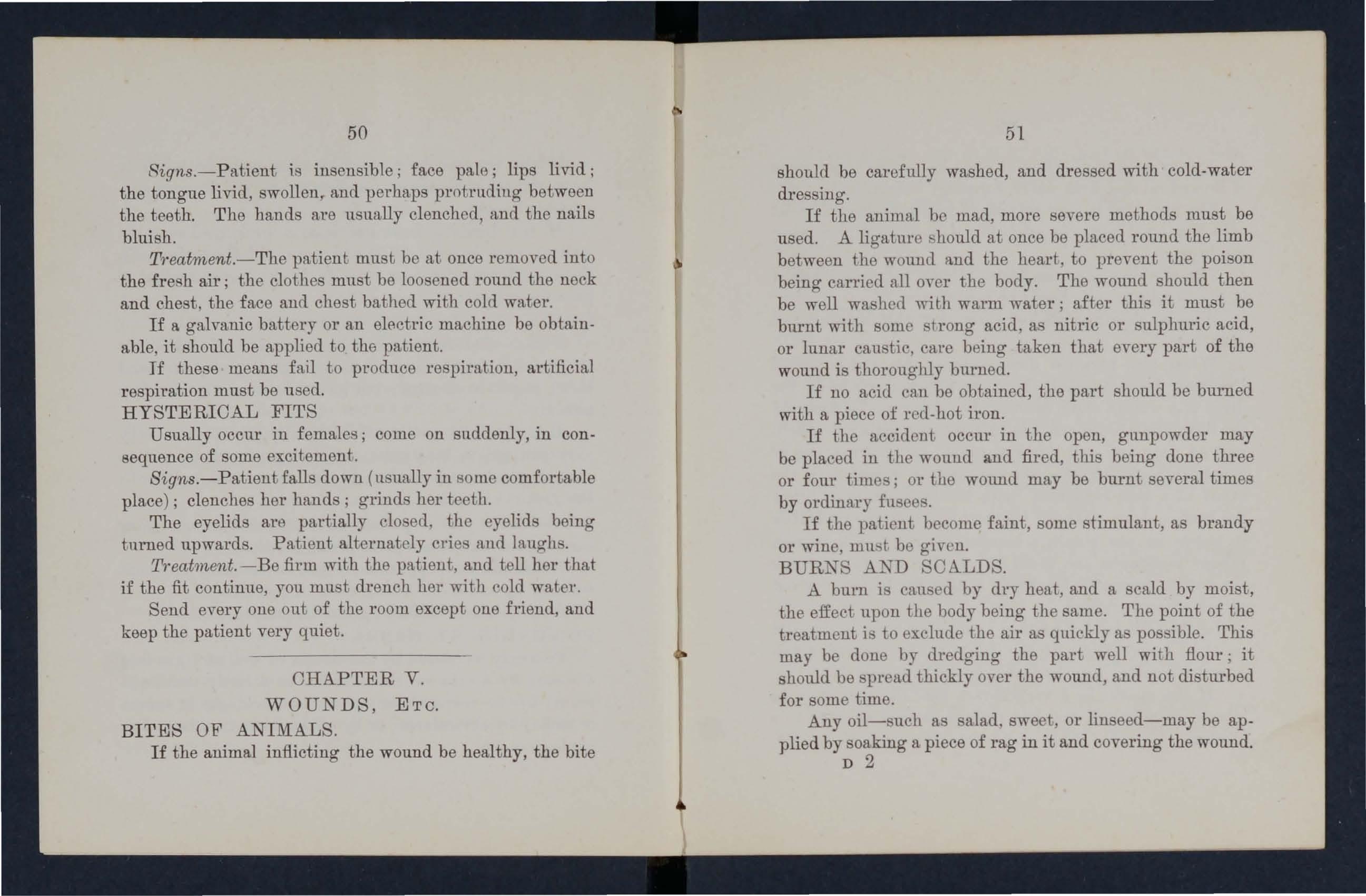
51
should be carefully washed, and dressed with cold-water dressing.
If the animal be mad, more severe methods must be used. A ligatme .'hould at once be placed round the limb between the wound and the heart, to prevent the poi on being carried all oyer the body. The wound should then be well washe(l with warm water j after thi it must be bm'nt with some strong acid, a nitric or sulphuric acid, or lunar caustic, care beinO' taken that every part of the wound is thoroughly bmned.
If no acid can be obtained, the part should be burned with a piece of rcel-hot iron.
If the accident. occur in the open, gunpowder may be placed in the wound and fired, this being done three or fom times; 01' tho wOlmd may be burnt several times by ordinary fusee .
If the patient become faint, some stimulant, as brandy or wine, lllHst, be given.
BURNS AND SC A.LDS.
A burn is caused by dry heat, and a scald by moist, the effect upon the body being the same. The point of the treatmcut is to exclude the air as quickly a pos'ible. This !Day be done by dredging the part well with flour j it should be spreau thickly over the wound, and not eli turbed for some time.
Any oil- uch as salad, sweet, or lin eed-may be applied by soaking a piece of rag in it and covering the wound.
D :3
52
A very good application is made by mixing equal parts of linseed oil and lime water, forming "carron oil."
, The plan that is vcry popular of holding aLum i.u frout of a fire must uever be adopted i it is simply increasiug the injury.
The clot,hmg must be removed yery carefully; but if it firmly adhere, oil should be poured over it.
Blisters should never be broken, but the dl'csslug put over them.
When any persou's dress ca.tches fire the advice of Professor John Marshall should be followed, viz. :-If the dress of a woman catch fire she should at ouce He down ou the floor, and should crawl ill this positi.on either to a bellpull or door and call for assistance; 01' secure a rug or blaukot with which shc can smother the flames. In the eveut of a maureuderiug holp, he should at ouce till'ow the patient down, take off his coat aud roll the patient in it, uuless he cau obtain a blanket or ru,g; if a woman render assistauce she must be carelul 1l0t to approach the patient except by her head, so that the flameo may not attack her own clothes.
SPRAINS must always be Ll'caLed by keeping the part as quiet as possible. If the joint can be (,overed, a trio angular bandage may be fu'mly bound round it.
If the sprain be a very seyere one, the part. may be placed in a splint, and the patient carried at once to a doctor.
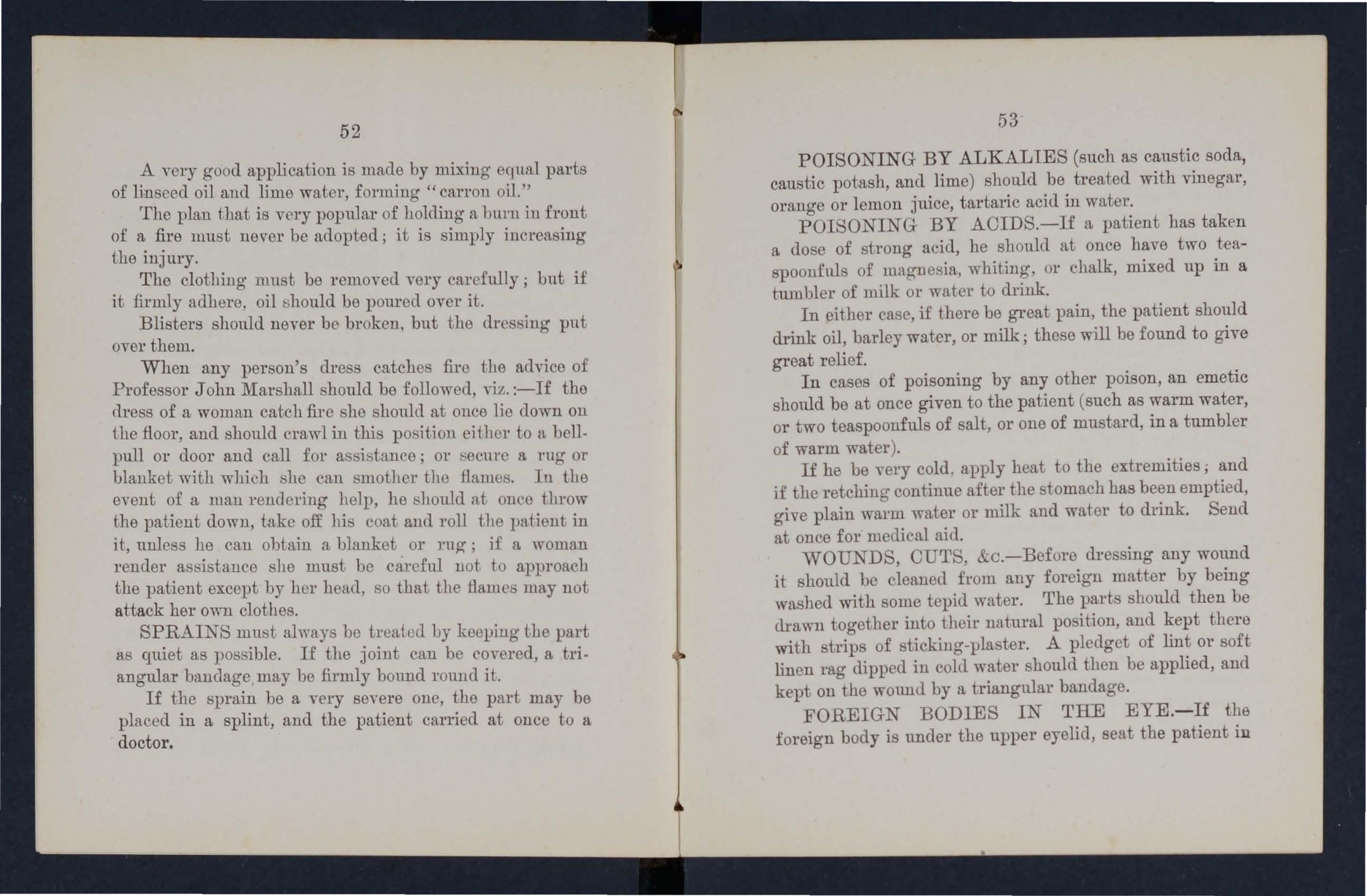
53
POISONING BY ALKALIES (such as caustic soda, caustic potash, and lime) should be treated with vinegar, orange or lemon juice, tartaric acic1 in water.
POISONING BY ACIDS.-If a patient has taken a dose of strong acid, he should aL once have two teaspoonfuls of magllesia, whiting, or chalk, mixed up in a tumbler of milk or water to drink.
In either case, if there be great pain, the patient should drink oil, barley water, or milk i these will be found to give great relief.
In cases of poisoning by any other poison, an emetic should be at once given to the patient (such as warm water, or two teaspoonfuls of salt, or one of mustard, in a tumbler of warm water).
If he be very cold. apply heat to the extremities; and if the retching continue after the stomach has been emptied, give plain warm water or milk and water to drink. Send at once for medical aid.
WOUNDS, CUTS, &c.-Befol'e ill'essing any W01IDd it should be cleaned from any foreign matter by being washed with some tepid water. The parts should then be drawn together into their natural position, and kept there with strips of sticking-plaster. A pledget of lint or soft linen rag clipped in cold water should then be applied, and kept on the wound by a triangular bandage.
FOREIGN BODIES IN THE EYE.-If the foreign body is under the upper eyelid, seat the patient in
54
chair, and, standing behind him, place a pencil over the lid; take hold of the eyelashes, and turn the lid upwards. Then, haling expo ed the substance, bru h it off with the corner of a handkerchief or a camel's hair brush. If it be under the lower eyelid, simply depress the lid, and proceed as aboye with handkerchief or bl·ush.
OHAPTER VI.
ARTIFIOIAL RESPIRATION.
ARTIFIOIAL RESPIRATION must be employed the breathing is very feeble, or has stopped, atl 1U cases of hanging, drowning, suffocation by gas, chloroform, carbonic acid, &c.
DIREOTIONS FOR RESTORING THE APPARENTLY DR.OWNED.
The following rll lp,s IUP taken from those laid down by the Royal National T.itphoat InRtitution :_
The points to be aImed at are-first and imm ediat ely, the OF BREATHING; and secondly, after breathrng IS restored, the PROMOTION OF WARMTH AND OIRCULATION.
The efforts to ?'esto?'e Breathing must be commenced immediately and energetically, and persevered in for one or two hours, or until a medical man has pronolIDced that life is extinct.
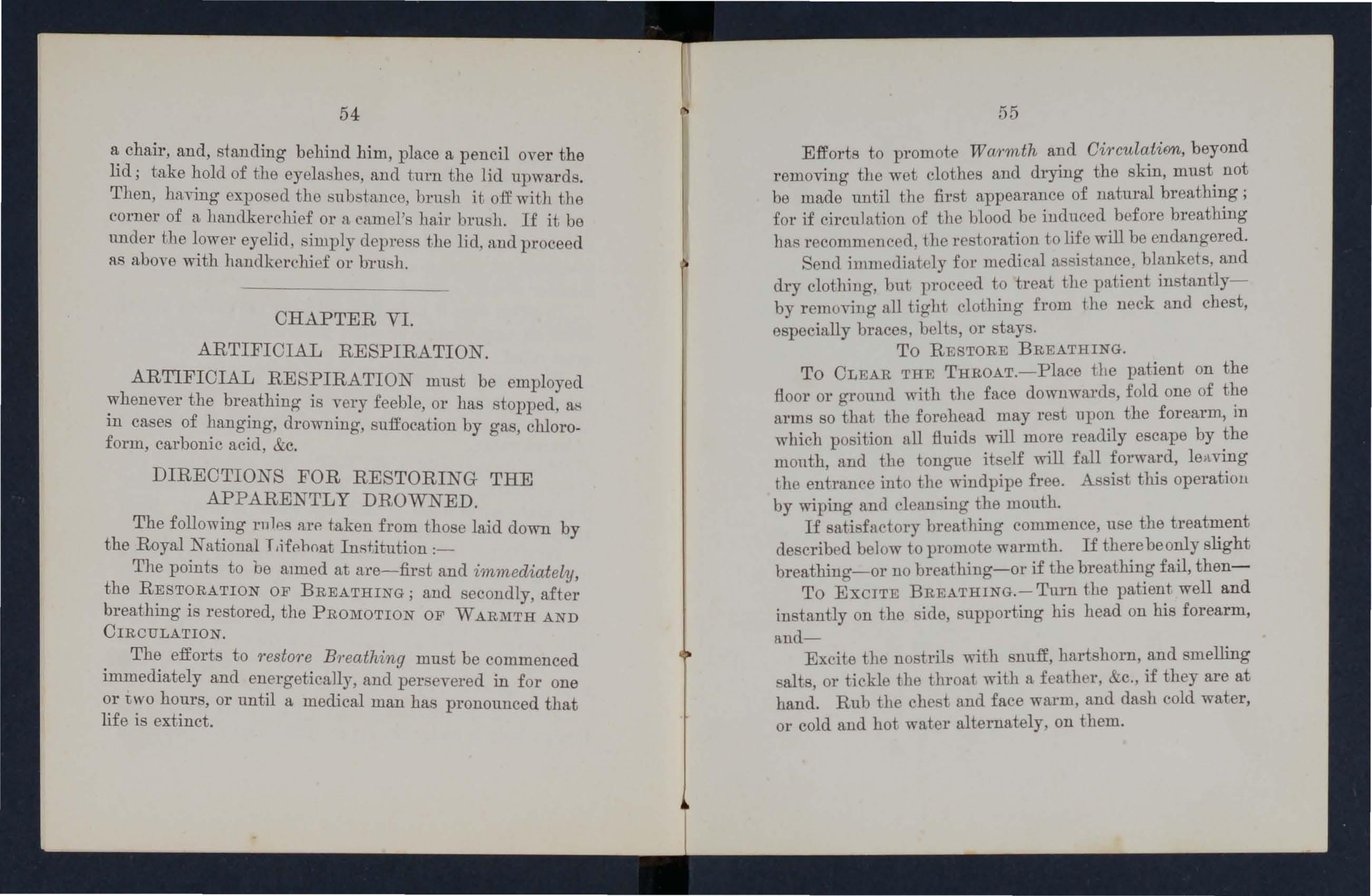
55
Efforts to promote Wa?'?nth and CircuZaiifm, beyond removing the wet clothes and drying the skin, must not be made until the first appearance of natural breathing; for if circulation of the blood be induced b efore breathing haR recommenced , the restoration to life will be endangered.
Send immediately for medical as sistance , blanket , and dry clothing, but proceed to treat the patient instantlyby rem oving aU tight clothing from tho nock and chest, especially brace , belts, or stays.
To RESTORE BREATHING.
To OLEAR THE THROAT.-Place t he patient on the floor or gTouml with the face dOWllwards, fold one of the arms so that the forehead may rcst upon the forearm, in which position all fluids will more readily escape by the month, and the tongue itself will fall forward, le Aving the entrance into the windpipe free. A sist this operatioll by wiping and clean ing the mouth.
If satisfactory breathing commence, use the treatment described below to promote warmth. If there be only slight breathing-or no breathing-or if the breathing fail, then-
To EXCITE BREATHING.- Turn the patient well and instantly on the side, supporting his head on his forearm, Imd-
Excite the nostrils with snuff, hartshorn, and smelling or tickle the throat with It feath er, &c., if they are at hand. Rub the chc t and face warm, and dash cold water, or cold and hot water alternately, on them.

.. ,.--('.----
FIG. 22.-POSITJON 1.
If there be no surress, lose not a moment, but in· stantly-
To IMITATE BREATHING.-Dl'aw tho t.onguc out ano keep it ont by means of nn elastic band passing o\'er it. and rounel the chin. Replace tlw patient on his fare, and snpporting his chest well on a. folcletl coat, 01' otbor article of dre s. (Position 1. Fig. PInce an assi. tant at the patient's head and make him bend the patient' forearm so that his forehead may rest upon it; during the whole of the movements of the body the head must be kept on a level with the rest of the body, by the assistant placing his right hand nnder the patient's forearm and his left on the back of the patient's head. Another assistant should be placed at the patient's feet" to belp turning him. If the patient's head be resting on hia right fore-arm, the person who turns him on to his back should kneel on his right side i if the left fore-arm be bent tbe opt'rator must kneel on the patient.' left side. Then turn the body very gently on the side and a little beyond, and then briskly back again on to the face, repeating these measures cautiously, efficiently, and perseveringly, about fifteen times in the minute, or once every four or fhB seconds, occasionally varying the side. (Position 2. Fig. 23. )
On each occasion that the body is replaced on the face, make uniform but efficient pressure with brisk movement, on the back between and below the shoulder-blades or bones

on each side, removing the pressure immediately before turning the body on the side.
(By placing the lJ(di e nt on the chest, the 1)) e ight of the bocly forces th e ((i1' out; wh en tnnwl on th e side, ihis p'reSSlwe is )·e111 0/)('(7, lind (I i ente1·.'; fhe ch es t. )
Whilst the ahoyo o}JCl'UtiOllS ;11'13 heing ))l'ocf'ccleel with, dry the hautls aucl feet. Hwl as . (Jon a. (h'y clothing or blankets cau be pro e'Ul'Ccl, strip the boely, and covel' or gradually re-eIothe it, but taking care not to interfere with the efforts to restore breathing.
DR. SYLVESTER'S METHOD.
Dr. Syl"ester's mel bod may be used if no assistance be at hand:-
Place tho patient on his back on a flat surface, inclined a little upwards from the fect; raise and support the head and shoulders on a lllall firlll cushion or folded article of dress placed under tho shoulder-blades.
Draw forwal',l th o paticnt' tongue, and keep it projecting beyonel the lipo; by an elastic band or piece of tape or string over the tongue and under the chin. Remove all tight clothing from about the neck and chest, especially the braces, &c.
To IMITATE THE MOVEMENTS OF BREATHING.-
Stand at the patient's head, grasp arms just below tho elbows, aUlI draw the lll gently and steadily upward itboye t.he head, aml J..eep th e m, str et c h e(l upwards for two seconds (Potiition A. Fig. 24). (By this means air is
58
d?'awn into the lungs.) Then turn down the patient's arms, and press them gontly and firmly for two seconds against the sides of his chest. (By this means ai?' is p?'essed out of the (Position B. Fig.
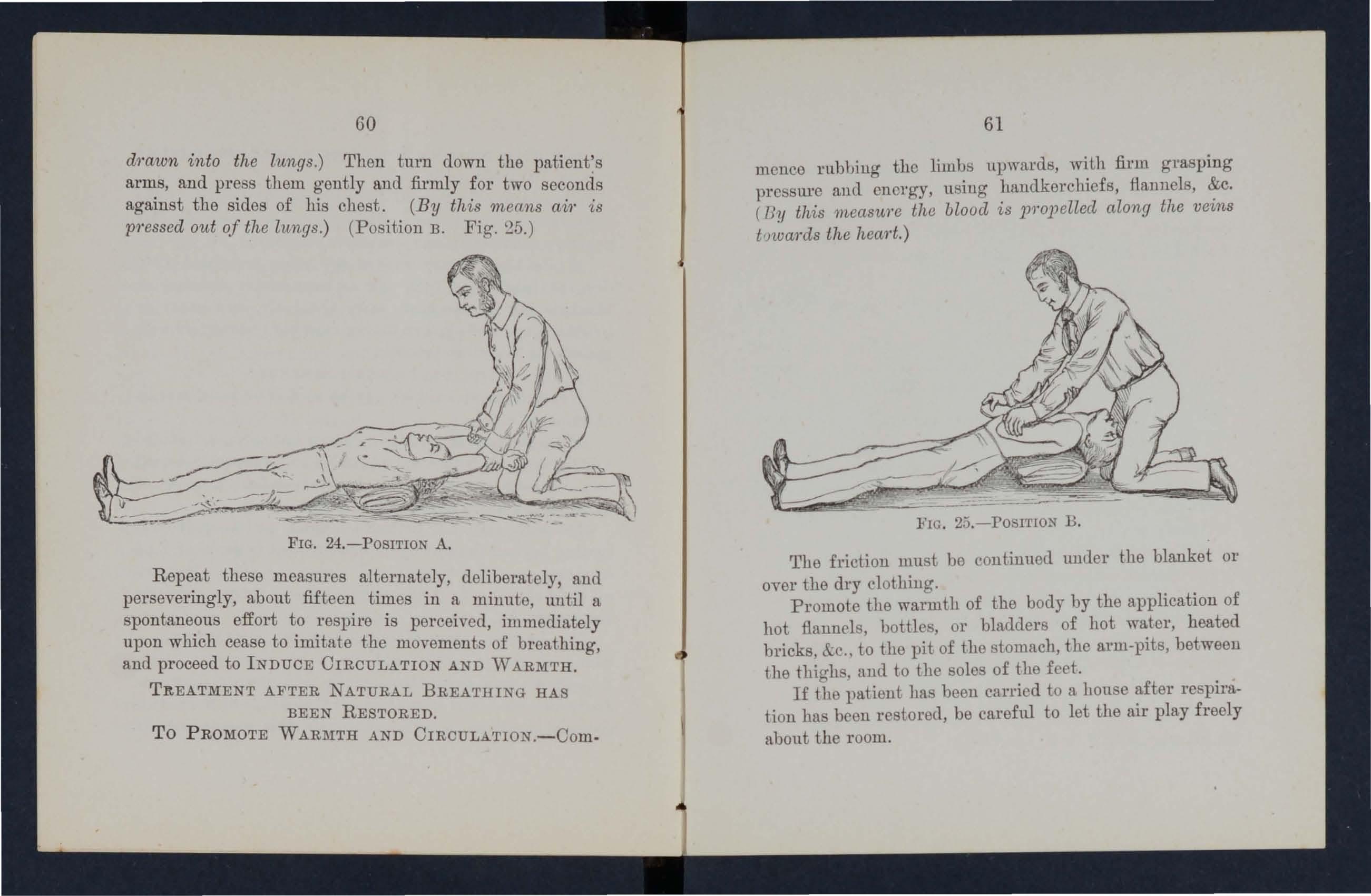
FIG. 24.-POSITION A.
Repeat these measures alternately, deliberatcly, ann perseveringly, about fifteen times in a minnte, until a spontaneous effort to respire is perceived, immediately upon which cease to imitate the movements of breathing, and proceed to INDUCE OIRCULATION AND \V ARMTH.
TltEATMENT AFTER NATURAL BREATHING HAS BEEN RESTORED.
To PROMOTE WARMTH AND OIRCULATION.-Oom61
menco rubbing the limbs upwards, wiLh firm grasping pressurc and energy, usmg handkerchiefs, flannels, &c. (Uy this measure the blood is )??'opeZZecl along the veins t r)wa'rds the hecwt.)
:FIG. 23.-POSITlON B.
The friction must bo continued unrler the blanket or over the dry
Promote the of the body by the application of hot fiann(>ls, bottles, 01' bladders of hot water, heated bricks, &c., to the pit of the stomach, the arm-pits, between the thigh, and to the soles of the feet. .
If th patient hI\. been carried to a hou e respll'ation ha beon restored, be careful to let the all' play freely about the room.
60
62
On the restoratioll of life, a teaspoonful of warm Wil.ter should be given; and then, if the power of swallowing has rettu'ned, small quantities of wine, warm brandy8J1d-water, or coffee, should be administered. The pa,tieut should be kept in bed, 8J1d a disposition to sleep encouraged.
If there be pain or difficulty in breathing, apply a hot linseed poultice over the che t.
Watch the patient carefully for some time to see that the breathing does not fail: should any SigllS of failure appear, at once begin artificial respiration.
GENERAL OBSERVATIONS.
The above treatment should be persevered in for some hours, as it is an erroneous opinion that persons are irrecoverable because life does not soon make its appearance, persons having been restored after perseyering for many hours.
Appea?'ances which generally accompany Death.
Breathing and the heart's action cease entirely j the eyelids are genel'ally half-closed; the pupils dilated j the tongue approaches to the under edges of the lips, and these, as well as t,he nostrils, are covered with a frothy mucus. Ooldness and pallor of surface increase.
OAUTIONS.
Prevent unnecessary crowding of persons round the body, especially if in an apartment.
63
A void rough usagc, and do not allow the body to remailJ on the back unless the tongue is pulled out.
Under no circumstances hold the body up by the feet.
On no account place the body in a warm bath, unless under medical direction.
OHAPTER VII. BANDAGING.
ESMAROH'S TRIANGULAR BANDAGE (Fig. 26) may be applied to any part of the body. It is made
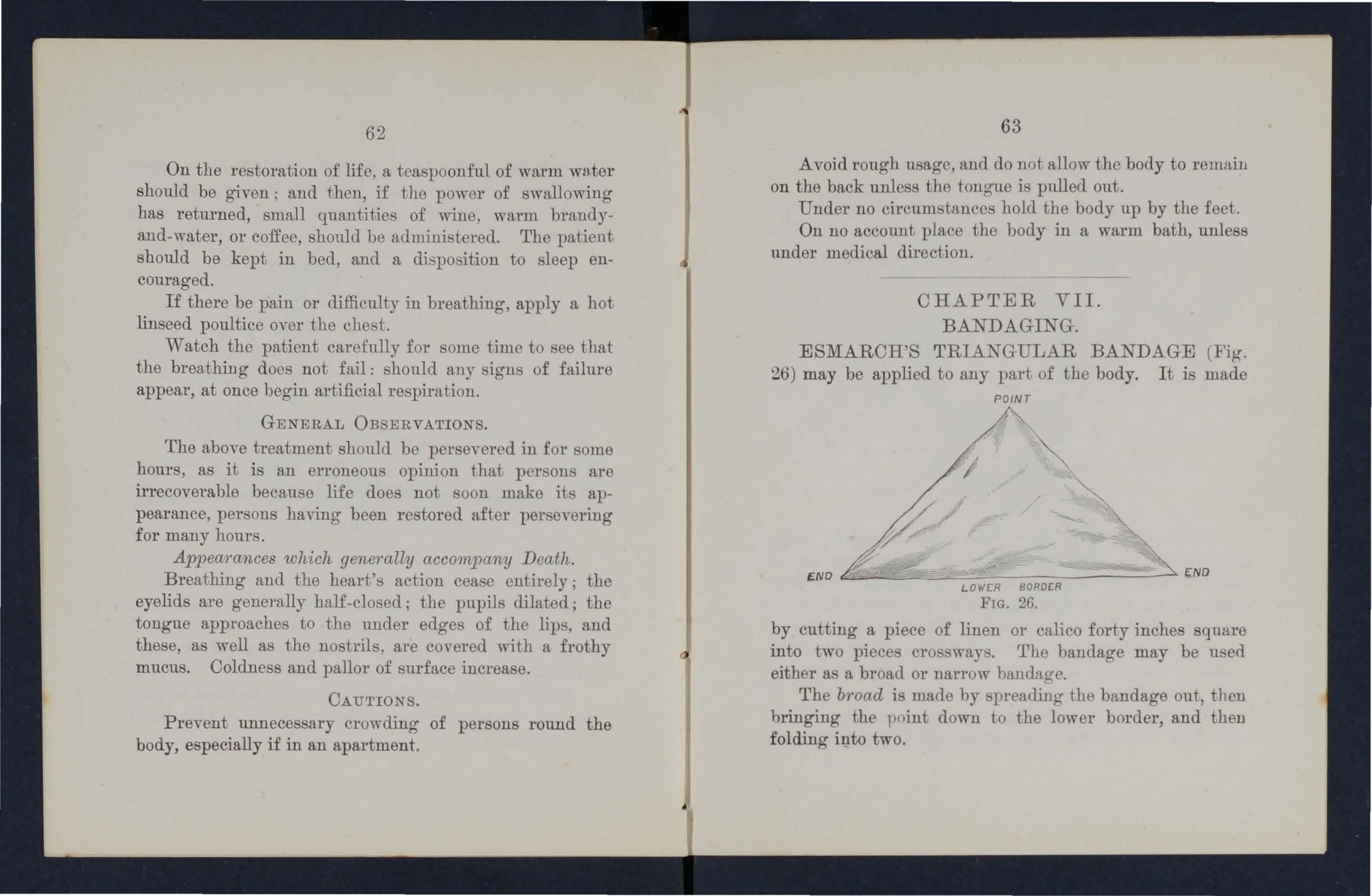
2G.
by cutting a piece of linen or calico forty inches square into two piece cro sways. 'rhe bandage may be used either a a broad or narrow hancL'tge.
The b?'oad is made by spreading the bandage out, then bringing the point down to the lower border, and then folding into two.
POINT / END f;NO LOW ER BORDER FIG.
The na?TOW is made by drawing the point down to the . lower border, and t,bcn folding into throe.
The bandage should always be fastened eithor by a pill, or by being tied with a reef 1.1lot (Fig. 27). It is applied to the body as follows :-
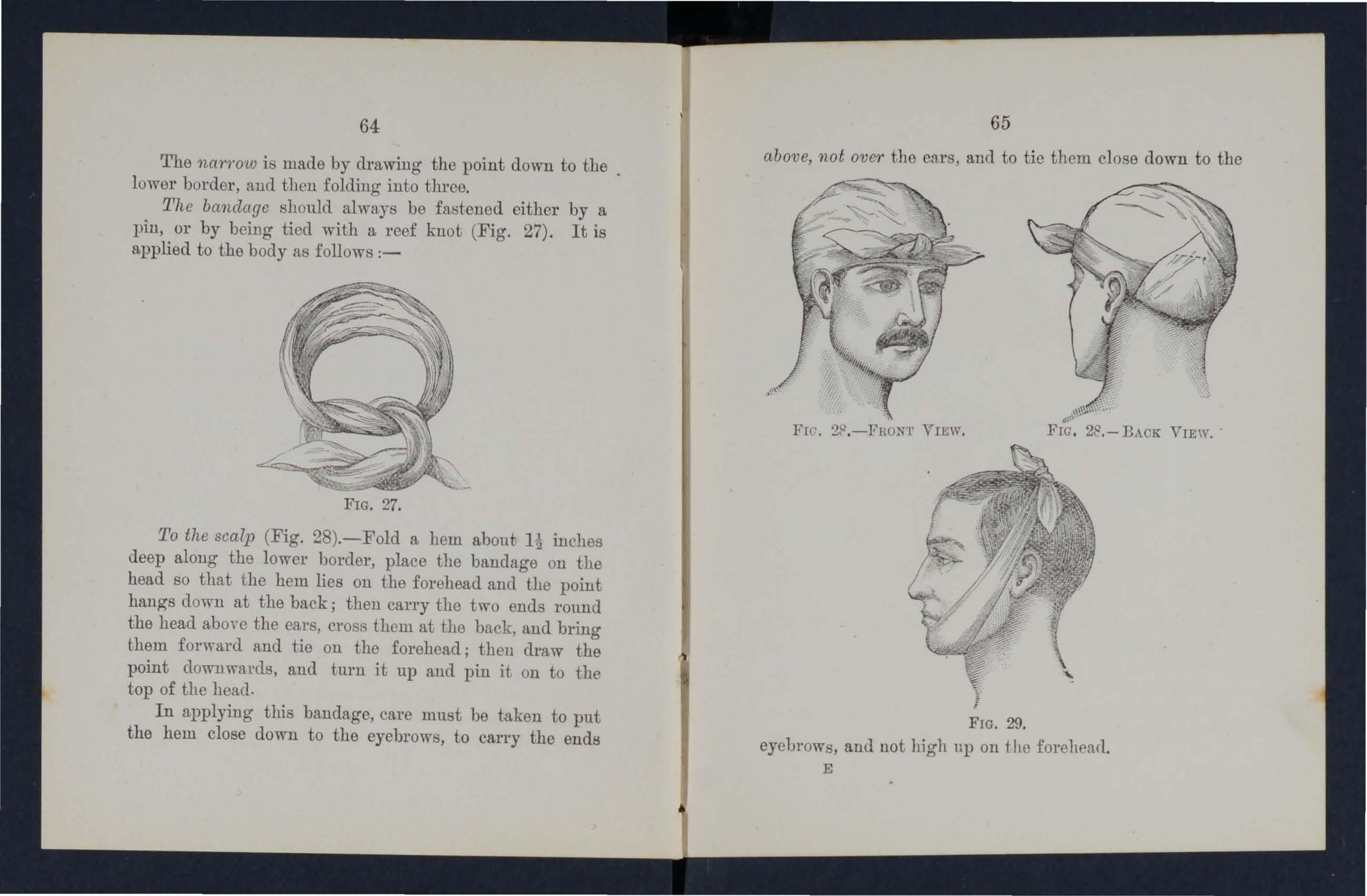
27.
To the scalp (Fig. 28).-Fold a hem about H inches deep along the lowor border, place the bandage on the head so that the hem lies on the forehead and the poin t hangs down at the back; then carry the two ends round the head above the ears, cross them at the back, and bring them forward and tie on the forehead; then draw the point downwards, and turn it up and pin it, on to the top of the head.
In applying this bandage, care must be taken to put the hem close down to the eyebrows, to carry the ends
65
above, not aVe?' tho oars, and to tio thorn close down to the
FIG. 29.
eyebrows, and not high np on the forehen!l.
64
FIG.
FIC. 2P .-FIWNl' VIEW. FIG. 2P.- BACK VIEW
E
66
For the jaw, 01' side of face (Fig. 29), apply centre of nal'l'OW bandage to the point of the jaw, and carry tho ends on to the top of the head, and t,ie (Fig. 28).
For the f01'eheacl, side of h eacl, eye, che ek, fm' any part of the body which is ?'ound (as the arm or thigh, FIG. 30.
&c.), the narrow bandage must be used, its centre being placed on the wound, and the ends being carried ronnd the limb and tied over the wound.
FO?· shoulde?' (Fig. 30).-Place the centre of a bandage on the injured shoulder, with the point running up the side (l)f the neck j carry the enrls rOlmd the midclle of the arm
67
and tie them j take a second bandage, fold it into a broad bandage, place one end over the point of the first bandage, sling the arm by carrying the other end of the bandage over the sound shoulder, and tying at the back of the neck j bring the point. of the fin;t bandage lmder that

FIG. 31.
part of the sling resting on the injured shoulder) draw it tight, turn it down, and pin it.
Fo)' hip (Fig. 31).-Tie a nan-ow bandage round the body above the haunch bones, take another bandage, turn up a hem according to the size of the patient, place its centre on the wound, carry the ends round the thigh, and E 2
68 tie them; then carry the point up under the waistband, tm'n it down , and pin it.
Fa?' the hand (Fig. 32).-8pread out a bandage, place

FIG. 32
the wrist on the border with the fing ers towards the point; then bring the point over the wrist, pass tho two ends over the wrist, cross, and tie them.
FIG. 33.
Fa?' the foot (Fig. 33).-8pread out a bandage, place
69
the foot on its centre with the toe towards the point; draw np the poiut ovor the instep, bring the two ends forward, cross, and tio them either on the sole (if to keep a splint on) or round the ankle.
La 1'ge ann. -sling (Fig. 34) .-8p1' cad out a bandagc , put one end ovor the sound shoulder, let the other hang dow11 in front of the chest. Carry the point behind the elbow of
FIG. 34.
the injured arm; bend the arm fOl'wal'll oycr the middl e of the bandage; then carry the second end over the shoulc1t·r of the injured side, and tie to the front end; bring the point forward and pin to the front of the bandage.
S -mall ann-slilly.-Fold the bandage into th e broad
.. I
b::tndage; thon place one end o,er the shouMer on the sound side; cross the ::trm over the lllitldle of the bandage hanging down the chest; then bring the other end over tho injured shoulder and tie at the side of the neck.
Fo?' chest (Figs. 35 ::tnd 36).-Place the middle of the bandage on tho injured side, with the point over the

FIG. 35.
FIG. 36.
shoulder; carry the two ends round the waist a11(l lie them; then clraw the point o,er the shoulder and tic to Olle of the ends.
Fo?' the back-The bandage is applied as alHlye, 1 ut beginning by placing the bandage on the back.
CHAPTER VIII. CARRYING PATIENTS.
III acciclellts whero the patient has been rendered nll:lhle to walk alone, he may be carried by the bystanders making any of the following seats:-
ll.) The four-hancled is made by two persons claspillg' each other's wrist, as in Fig. 37.
This scat is u cd in cases where the patient is unahle to walk, but ah1e to give some assistance.
FIG. 37.
After the han,ls are elaspecl together, the bearers stoop down behind the patient, who sit on the Inulls, and at the same time places one arm 1'1)\11111 the neck of e:1c11 bearer.
70
I 71
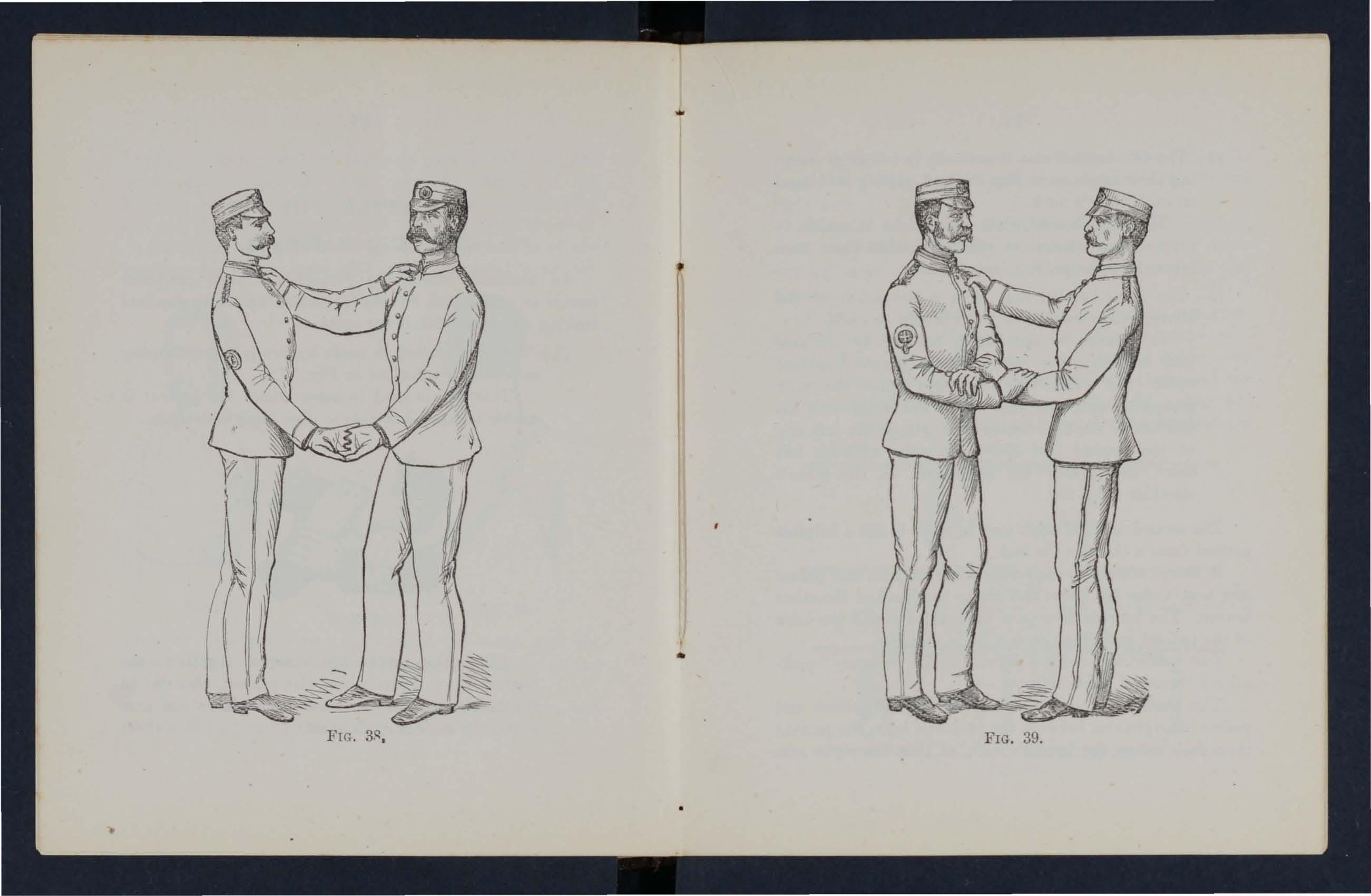
74
(2.) . The s.eat is made by two ben.rcl's claspmg theIr hands as m Fig. 38, and placing one hand on each other's neck.
This seat is used when the paticnt is unable to give any assistance, as when the arms bave been injured, or the patient feels faint.
(3.) The three-banded seat is a modification of the abo\-e, and is u cd for a short person 01' child.
It made by one bearer bolding up one Hl'Ill (say his left); the second bearer grasps just aboTe the wrist with his right hand; he thell grasps his own arm just above the wrist with his left hand; the first bearer then grasps the left arm of the second just above the wrist with his left hand, and places his right arm on tho other's shoulder (Fig. 39).
The second kind of seat may be used to lift a helpless patient from a chair to the bed.
A bearer stands on each side of the patient, and passes one arm under his kneos and clasps the hand of the other bearer. The bearers then pass their arlllS round the back of the patient and grasp each other's shoulder.
One bearer lllay carry a patient by the ordinary" pic.k, a-back" method, 01' as follows :_
The stoops down in front of the patient and passes his l1.ght arm between the patient's legs; the patient then falls across the bearer's back, so that his right arm

comes in front of the bearer's left arm. The patient is kept from falling by the bearer holding his right leg and right arm.
The 1?lan of canying the patient by the anns and legs, with the face downwards, commonly called the "f?'og' s 1na?'ch," must neve?' be used, as death ?nay ensue from this £?·eat?nent.
Where a proper stretcher cannot be obtained, a temporary one may he made in either of the following ways :-
(1.) The sleoves of a coat IDay be turned inside; two stout poles are then passed through them, and the coat buttoned. This makes a good seat. (Fig. 40.) The patient sits on it, and rests against the back of the first bearer.
CFIG. 40.
If a larger stretcher be required, two coats must be heated in tJlC same way. (Fig-. 41.)
75
,
(2.) Two sacks may be taken i a hole is mado in each comer of t,he bottom, and two polos pnssoel thro ugh the sack and out of the holes. (F ig. 42 .)

:FIG. 42.
(3.) .A. large piece of carpet, sacking, tarpaulin, or It blanket, may be spread out, alld two stout poles r olled up in the sides.
TW'o bea:'ers then stalld on each siele. They grasp the mIddle of the pole with one hand, anel near the end with the other. To carry the patient they must walk sieleways. '
(4.) .A. hurdle, broad piece of wood, or shutter, may be employed as a stretcher i but if either of them be some straw, or clothing, should be placed on th.cn a plece of stout cloth or sacking i the sacking IS useful in taking the patient off the stretcher when he a.rrivcs at the bed-side.
Tempor2.ry stretchers must be carried, and thc patient placeel on them as laid down in the" Stretcher Exercises."
OARRYING INJURED.
BY MR . JOHN FURLEY. , ..
HITHERTO the instruction given to the Classes of the St. John An.bulallce Assoe;iatiun, on the removal of ick and Injured persons 11y streh:hers or improvised methods of trallsport, has Lcen ioulldeu on Rules laid down in Professor Longmore's on the TlunslOlt of Sick and WOUl.ided."
But it has been amply proved that rules necessary for drilled and disciplined Locli s of men, such as the .A.Jmy Hospital Corps, are not applicable to those who undergo a brief trainwg to enable th<:m to first aid in the accidents of civilliie. In the majority of cases III which a certi£<:ated pupil is called upon to act, he has to look for assistance frolll men who have had no such in&iTuction as he possesses, when::rs every member of a military bearer COlll11any is chilh:d to "ork with others, and when three or four of such men have been numb ered uff, each knows what is expected of him.
The regular d.rill required for a bealer comlJuny in the .Al1UY is therefore not the best for a class of pupils of this Association.
On alaraue grollnd, or in a military hospital, there is generally plenty 0 Epa,ce, and one system of lifting and can-ying can be adopted, uut the aceideuts which happen in civil life make it uecessary that much should be left to the intelligence aLd experience of those ·who have to render finst aiu . For instance, when a patient has to be placed 011 a IStretcher in a cottage, in a factory crowueu with machinery, or in the tortuous passages of a mine, it would be quite impossible to follow the directions given in the "Manual of Exercise for Stretcher Bearers, and Bearer Companies," but the stretcher must be put at the side of the patient or in any other position possible, and the bearers must act acconlillgly, under the direction of one of their party.
76
78
On this subject Professor Longmore has said: "The military rules wcre framed for service in the open air, wher e there is, of course, plenty of space, but all such rules must be modified according to circumstances. It is well, I think, to teach the system which is thought to be best, and at the same time to prepare persons for doing that which is next best, when what may be best under other conditions ceases to be applicable."
The following rules have been dr'awn up to supply a waut which has been felt, and frequently expressed, by gentlemen of the medical profession, who have kindly devoted much time and attention in the givrng of First Aid Lectures. It may also be added that during the last two years they have been practically in more than one active Centre of the Association.
l' or purposes of dr'ill, numbeling the bearers will be found us eful whenever three or four men, thus instructed, find themselves in a position to work together; they will act with less hesitation, less liability to accident, and with more speed; but it must be repeated that in nearly all ordinary accidents, an efficient bearer will have to select his assistants without previous notice, and gi,e them his directions as briefly and clearly as he can. The most important point is to understand the pnnciples which have dictated the rules laid down in the Exercises.
N.B.-It is not pretended that the following Stretcher Exercises will be found equal to every circumstance that may arise. For instance, the placing of a stretcher in a road-cart or railway carria ge Dlust depend on the shape of the vehicle, and perhaps on the width of a uoor. It would occupy too much space, anu then, perhaps, the directions would be found inadequate, were attempt made to suggest plans for all cases. From personal experienceand we are daily assisting in the removal of invalilis by road and rail-we are satisfied that those who take the trouble to attend the lectures and qualify themselves for the certificate are fully able to meet exceptional difficulties as they arise. Instructors and pupils may, however, be reminded that whenever necessary the trctcher issued by thb Association may be lessened in width \vithout inconvenience to a patient upon it.

STRETOHER EXERCISE, No. I.
For three Bearers. To be used when space will allow.
1: as he will have to bear the heaVier pu.rt of the bUl" d1ll' orders will be given by No.3.•
2 "PLACE THE STRETCHER." .
. No 1 takin"" the head of the stretcher, and No.2 the t in a line "ith ru.tiunt's body, the foot of the l:itretcher beIng c ose u his attends to the Patient, assisted by NOB. 1 and 2 when neces8ary.
3. "FALL IN.'' At this order, No.1 places himself a.t the Patient's right side, o. :2 at his leftside, and the Pabpnt's No.3 takes pos1tJ.on on the lDJUl"ed 81 e In a e WI knees. nruel to look after the injUl"ed part of :0 see tbat. no ?8.!ldages or displaced, and also that ? Bearer, In lifting or CUIT)'lIlo, ues no in liny way touch the Patient s feet.
"When e"erything ha been arnmged for the removal of the Patient. the Ol"der wJ.ll be giv,"n-
4. "READ Y." . . 1 an,l :2 now Pilch sink dvwu on one and t:ach other" hand::; the shoulders and thig-hR of the Patle;nt, t 3 plat.s his h 'md underneath the lower limb::!, alwa.ys takin9'" 10 case 0 a to have one hand on each side of the seat of InJW"y.
5. "LIFT." .., .
All three Dearers rise together to theIr feet, keepIng the Patient ill a horizontal pu!!ition.
6. "MARCil." ....
All take short ::;id0-paces until the Patient shead 18 over the p1llow of the stretcher.
ilenn'ra 1,,' to rake any of the,110, ilion8 named 10 the r.. ll .. wing b: whl' tuer tU:lt ot No.1, 2, S, or 4 Bearer.
79
7. "HALT."
All three B earers remain steady, and wait for the next order.
8. "LOWER."
Patient is placed gently on the Stretcher, and the B earers then stand up.
9. "FALL IN." On this order being given,
No .. 1 places himself at the head of the stretcher with his face towards the No.2 at foot with his back to the ratient, and No.3 places himself at the SIde of the Patient.
10. "READY ."
1 an?- 2 stoop d.own and grasp the handles of the stretcher, haviog preVIously adjusted theIr shoulder-straps in case they are used. No.3, as soon as he sees all is right, gives the word-
11. "LIFT ."
']'he stretcher is now raised to position r eady for moving off, care Leivg taken to keep the Patient's head above the level of his feet.
12... MARCH." On tlill! word being given, No.1 steps off with the left foot, and No.2 with the right. step should a short one of tweuty inches, and taken with bent knees Just from the hips.
13. "HALT."
The place of destination being reached, on the word" HalL" 1 ein' given, the Bearers remain steady in positio n. ,..
14. "LOWER."
At this order Beal'ers place the stretcher on the ground, aou thpu belOg taken to let the Patient's feet re(wh the grolllld
15. "UNLOAD STRETCHER-READY."
Th e Bearers prepare to take the Patient off the stretcher.
16. "LIFT."
The Bearers raise up the Patient as before instI ueted.
17. "LOWER."
Patient is care!ully lowered upon the vehicle, bed, 01' other place to which It has been desIgned to carry him.

STRETCHER EXERCISE, No. II.
For four Bearers. To be usod when there 1s not sufficient sp ace for carrying out Exercise No. 1.
l. The Instructor numbers the Bearers-I, 2, 3, 4. All orders will be given by No.4.
2. "FALL IN."
At the words r, Fall in," Nos. I, 2, ann 3 take position on one l<ide of the Pt.tient No.1 places himself at the ratienVs shoulder, No.2 O('ar the nwldle of the body, ,LTO. 3 near the Patient's feet. At the same tilDe No. <1 places the st;-retcher on the ground by the other side of the PatIent, and relllains standing near it;.,; centre, facing the otber Bearers .
3. "EEADY."
Nos . 1, 2, and 3 stoop down, and kneel on the left knee if tlJey are on the left side of the Patient, on the right knee if they are on the right side of the PatIent. They then proceed to take bold of the Patient :-No. 1 passing one of his arms belleath the Patient's n eck and the other under his sl{oulder-blndesj No.2 passillg both arms under the middle of his body, one above, the other below the buttocks; and No.3 passin" both arms under the lower in caRe of fracture, when he must place one haud 00 each side of the broken bone, so as to steady it. No 4, when the WOld .r l:<eftdy" is given, should place himself opposite No.2, stoop down and lock his hands with No.2 under ilie Patient's body. If the Patient be able to belp he should clasp his hands round the neck of No. 1.
4. "LIFT."
On the word" Lift " the Bearers raise the Patient gently and rest him on their knees; as soon as he is securely rested, No.4 runs round by the head of the stretcher and pl:l.Ces it under tbe Patient, being careful that the pillow i immediately under the Patient's head; he then stoops down and locks his hands with those of No.2.
5. "LOWER"
At the word" Lower," Nos . 1, 2, and 3 'carefully lower the Patient down to the stretcher, while No 4 at the 8ame time assists in supporting and placing him 00 It. F
80
81
6 " S TAND TO STRETCHER."
On this order being given, each Bearer stands up :-No. 1 goes to the llPud of the stretc11er with his face towards the rtLtient ; No 2 tv the foot, with his back to the Patient; while Nos. 3 and 4 remain in IJositJon on each side of the stretcher.
7. "RE a DY."
1 and 2 grasp the handles of the stretcher, having previouL'ly adju ted their shoulder-shaps in ca e they are using them .
8 "LIl!T."
At this word, N os. 1 and 2 Bearers raise the sb:etcher steadily together and stand up.
9 . "MAR CH ."
All being ascertained to be in order, on the word" March" beillg g-iven, Nos. 1 and 2 Bearers moye off :-No. 1 stepping off witb bis left fO(lt , and No 2 with his right foot. 'os. 3 and 4 mal'cb on eacb sido of {he stretcber. On al'l'iviDg at the place of debtination, the following orders are successively given :-
10. "HALT ."
11. "LO WER."
12. "UNL O AD STRET C HER-READY."
13. "LIFT. "
14. "LOWER."
N.B.-These ord ers, viz., N os. 10 to 14 inclusive, are to be carried (Jut n a similar m anner to orders N os. 13 to 17 in Exercise No 1.

STRET OHER EXE RCISE, No. III.
'When only three Bearers are available, and the space is limited as before, the following alterations must be made in t h e foregoing (No . 2) Exercise.
1. The Instructor numbers tbe Rearers-l, 2, 3. All orders will be given by No.3.
2. STRETCHER."
No 1 Bt.:arer placcs the stretf'hcr on thc grollnd by the id e of the rutieut, and Il:! close to him as pTll.eticable.
3. "FALL IN.''
The three Bearers take the same positions on one side of the Patient ll1.id down in Exercise No.2 .
4. "READY."
Nos. 1, 2, and 3 kneel down, placing themadves as elose to the Pa.tient as they conveniently ca.n, and then take hold of him as directed in Exercise No.2
5. "LIFT."
Nos. 1, 2, and 3 raise the Patient as directed in Exercise No . 2.
6. "L O WER."
At the word" Lower," Nol'l 1,2, and Slean forward so as to carry the Patient o,er the stretcher, and then carefully lower him down upon it .
7. "STAND TO STRETCHER."
At this direction No.1 goeq to the hea.d of the stretcher, No.2 to the foot, and No.3 remains in pusition at the ide of the stretcher.
The remainder of this Exerci. e will be precisely the same as is gi'\"en in Exercise No 2, from orders 7 to 14, both included-the in truction for No I B earer to walk by the side of the stretcher being alone omitted.
F 2
82
83
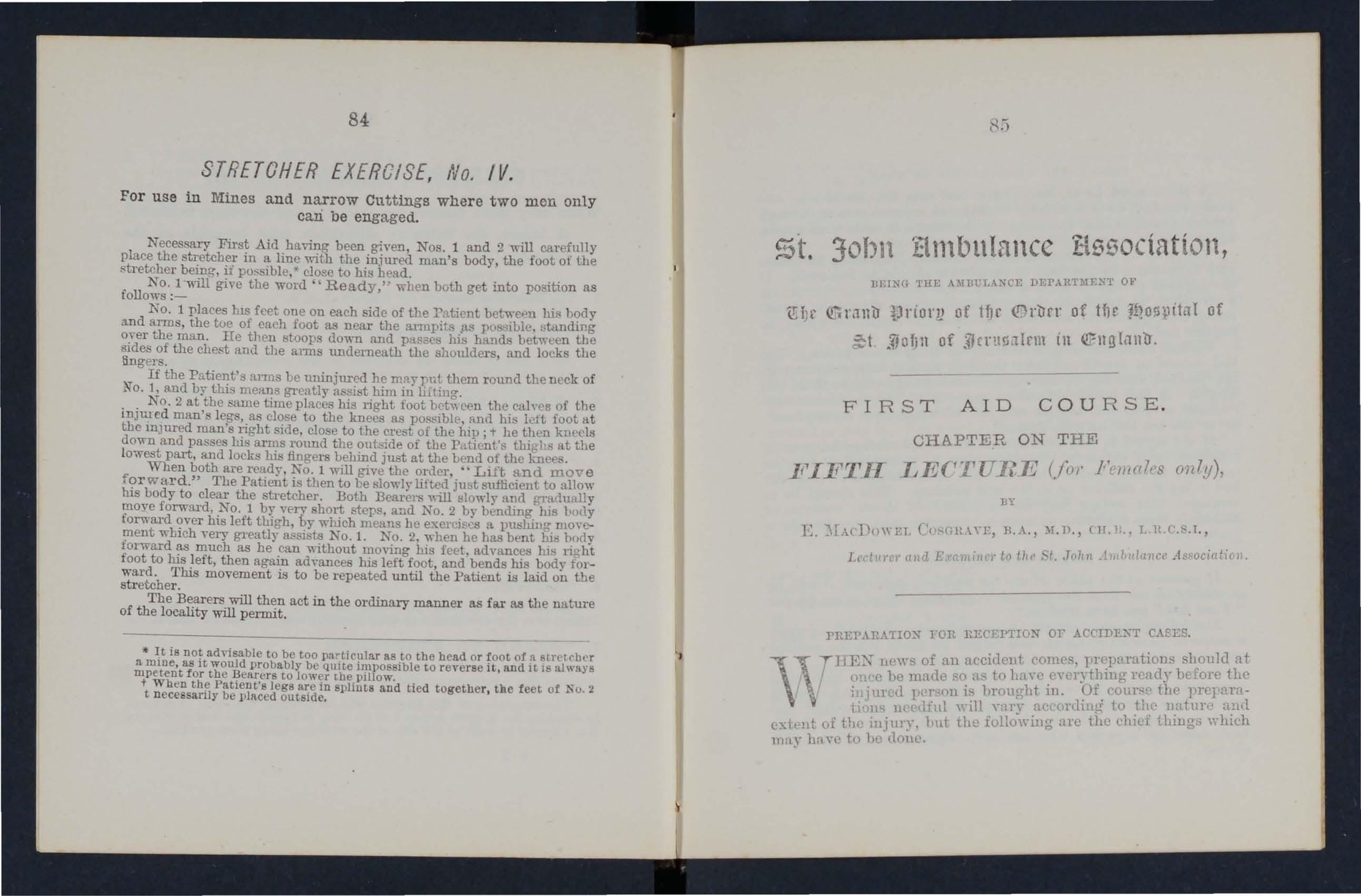
STRETOHER EX ERCISE , I/o. IV.
For use in Mines and narrow Cuttings where two men only can be engaged.
Necessary First Aid hating been given, Nos. 1 and 2 mll cal' fully place the stretcher in a line with the injured man's body, the foot of the being. if Ible,* close to hi.s bead.
No. 1 will give tbe word" Ready,' v.hen both get into position as follows :-
1'0. 1 places hIs feet one on each side of the P a tient beh\'e"ll hif< body and arms, the tue of each foot as near the armpits ,as POR 'ilJle, .tanding o\'er tbe man. He th en stDOPS down and passes his hlmds betwt:en the !3ides of the chest a.nd the arms underneath the shoulders, and locks the ling ers.
If the Plltient'6 anus be uninjured he m Ay uL them round the neck of No.1, lind by this means greatly a::;sist him in lifting.
, No.2 at the same time places his right foot b('t\\('(>n the caIn's of the tnJilled man's legs, as close to the knees as pOllsibl e , anrl hb lett foot at tbe illJured man's I;gbt side, close to the crest of the hip ; t he knerls down and passes hi· arms round the outside of the Patient"'; thi g-h ' at the lowest part, and locks hil:; fingers behind just at the bend of the knees.
When both are ready, NO.1 will gIve the order, ., Lift Ilnd move fC?rward." The Patient is then to l e slov.ly lifted just sufficient to allow his body to clear the stretcher. Both Bearers will slowlv and gra<lulIlly move forward, NO.1 by wry short steps, and No.2 by bendmg his hotly forward over his left thigh, by which m eans he exercises I\. pu,;hillg movement wbich very greatly assil:iis No. 1. No.2, when he has bent his hody iOlward as much as be can without moving IllS feet, adnmces his l;ght foot w his left, then again ad,ances his left foot, and bends his body tOlward. This movement is to be repeated until the Patient is laid on the stretcher.
The Bearers will then act in the ordinary manner as far as the nature of the locality will permit.
* It is adnsable to be too particular as to tbe bead or foot of fl strl"t rbL'T a mloe, as It would probably be qUIte impossible to reverse it, and it IS always mpetent tor tbe Bearers to lower the pillow.
t When tbe Patient's legs are in splints and tied togetber, tbe feet of No.2 t necessarily be lllllced outside.
84
st. 30bn tllnbllIance :t1aaociatioH, (£'il\l11tT iJriory of tIll' tJ)rtTrr of tf)t 1!101Ji-lltilI of RJofjll of jlCl'!I!J .1Irm ill \r-nolantT. FIRST AID COURSE. CHAPTER ON THE LE('l l URE (jiJi' F I' II/(Il es on '!}), TI t 13. ,\ I.Hl) (, \\ET. 'O.G H \.\,F., B.A., )r.])., (H. B L lt C.::-.T., ]. (' tt,rC!' ll id E n lidiler to /1 , ,' . .1, 1t1l AillllI, la ll c, ' ASF oc ;rt/i ( p .
cnOlCE AND Pln:I'An_\.TJO::\' OF noo)[.
A room must be choseu In ':\, b 1 tl ' easily reached, as it is t :, Ui:! bhoultl be olle uar:'ow passages aud u) stairs 0 C.,Ulj au pCI' 'on through uO'tlmst it th ' , 'd I "lnless IS somo such I.:casou b T ,0 lllJUle person s owu room IS best and P1l,ol'jjecting fumiture the in' d .' . U )lei:! s ou t )0 1'cmo\"ed If a stretJcuhree . person lIS cfurned on .a door or shutter or ou I, a coup 0 0 strong kitchc h'" 1 ' l'eady to support it whe1'c\"er tl b n .c . R LOult! placed require rest.' 10 ealeIS" ould he lIkely to bed from, the bedl:oolll. The
0 0 e s LOlu( j>e 'Yot ]'e'1(l' If tl ' collalls6 seyeral hot hottles illld .'.J. Ine 1::; co\"er the hot b ttl . 'il fi bLlllke1.s may be rCIIUll'l:ll . o es "1 1 aunel '

If tll,' inj 111'('<1 pf'l'S01l is insC'lIRihl(' fll1nthl'l' lwlppl' l'lllnuhl support his head.
The liftcrs, one at ench side, bhould kneel ou one knee, and puss their hauds lllHlcr the IlHtient's back at the lower part of the sllOulder blullcs, uml umler the hips, clasping each his right hand iu the other's left. The llljured patient should, if practicable, place hi::; arms round the uccks of the l)earel' ,
The third helper should attend to the seat of illjnry ; if this is a fruci1ll'cd limb, he should l;upport it 1»), placing the palms of hi· hauds uuder the limb, one abo,'e and oue below the scat of the injury, gmsplllg it firmly but aYoicliug ulluecesbary pressure.
The helpers should remain thus wltil the order .. Lift" is nml theu tlley should all lift slo'wly aud stenclily, (lYoiLling jan;, nttempts to chaugc position uf hauds, &c.
If the lllj mell persoll is to be placed on a stretcher or shutter, this 'honld be pI' '"iottsly lllaced with the bottom end at hi' head; thc ueurer::; should theu moye, oue at each sille of it, lmtil the pntient is over it. Tit!' \\"onl "Lo\\cr" should theu be giYcn, and the injurcd person t-.hOlll!111C Hlo","ly lowercd. A pilloW folded· lip enat t-.honld ue ready, alltllls the tillfIerer iH Inwered, tIllS ,'houl11 ll >placctl nml '1' his IW(l<l. :liLL'\"S OF c ..umYI::\'G.
0 1 , 01 C\ ell 1ll:1 y lH,: w;cd as :t
bed to'ii th a or a 1.al)le placetlnt'm" the y e su e1 eI on III the first 1W,t' n ' 1'1' 1 arranO'ed that soilin r lll<l' I '." I1S :.; IOltlel l)e so mate1ial thin oilcl J. l, no harm, ohl Shl'Cb, w<l terl'l'uol proteetio'n.
LIFTING AND CA.RRYING.
If at the place where the aecitlent it will j shee tbhat the patient is carcfully lifted at'ter llrOllt::: 1 as een rendered. '
The following rules shouhl he rememhered '-'olc -t tl of persons to as::libt, and do not let tl un how they <Ire to tlo it. 1 p.l H lIi , , . cases where the mjured perlSon has tu jlc Ii 'f > 1 velY .hOlt eli tauee, three helper:s are sufticicnt T' ('I l C! 11 be. as !ar as pos,ible of equal height) are to b'ea]' third IS to support find take ch:u'ue of the . . . 1 <> t,. th,l! hest dOlle h· I b lll] UJ e( pInt TIns IS "01I1'SC ) a person w LO has been through It ,. ,Ai;l :,
Beside' a i'trdchfl', nUll sul>stitutl'i' such as a gate, a shutter, or a door, other 1lll':tllS of cllrryillg" call h e illlproyi,;cl1. Iu illj mies where the iuj ured person is llllahle to walk, hyo hearC' rs can e:IlTY him by formillg a fOllr·hallllcc1, thrL'e· hallllec1, or t\\"o-hnlllll'll :-:<cat, A fom'·lwwletl :>eat is thUlS fonned :-To lli::;t1nguitih the helpers they are desigllatetl A amI B. Each helper grasps with his left haml the wlit uf his right hand; A theu grn,;ps with hifl right the left wrist of 13, whilst B with hi right haud grasp the Idt ",ri.t of Thus It square seat made. The helper::; stoop down, the mjurctl lll'I'. on sits Oll the huntls, nud place::; hi arms ou the bhouhler::; 01' rouml thL' neck::; of the helpers, who then rise. The lle1pns lllll;;t nelYallce sitiewanls, ycry ::;lo",ly and keep· ing in sit'p.
_\.. thl'ee-halllh.\l spat is thus 111:\111': .\. grasps llis right "Tist
with his left hi1llrl, with hiR right hnllll he g'l'll:-;ps D's right wrist, aud E 's right hanl1 grasps A's left 'Yl'ist. B thou 111nces his left hand on the right shoulder of A, anel a seat with n. hn.ck to Stlllport the injured person is made.
A single help or can lift ll}' snpporting with ouo arm the two 101ees, and with tllO athol' the uack. The arllls mllst be pnssed ,yell uuder beforo commencing to lift.
A single helper can giYe support by putting his right ann round the waist, gmsping the right hips lUlLl placing the iujmcd person's left arID round his o\yu neck, holding the left hand "'ith his own left hand,
A capital stretchor can be improvised out of a strong sheet ancI byo .broom handles 01' other short poles. Each side e;f the sheet is " Tound up on a broom handle until there is JURt room for a perRon to li e between. This requires four bearers, two at each side, to prevent the sheet slipping,
CARRYIN G UP STAIRS.
In carryiug a stretcher up stairs the hC:l(l shnuhl go nrtlt, [lJHl an extra helper shoulll at the lower eud so as to 1'11ise it <Iud keep the stretcher nearl.\' hori7.ontal.
The two, three, or fOllr·lHlll,1ell seat may be u:;c,l for l'al'l'yillg np sia.irs; or il strollg chair, the patieut being c:ll'l'il'd 11}1 backwards. In the btter case aile helper walk after tllt, cllllil' and heIr> to support it, and to prevent the injured P(-1'.';OI1 slippillg out.
LU'TING BED.
If the be(l is nalTOW and there is room the stretcher sholll<l he placed ou the floor \\ith the heall close to the foot of the Led. The iujured l)erson th"u l)e lifted oyer the foot aurl placetl ou the bed. If the bed is too wide to admit of this, the l>iretcher should be placed beside it, and two helpers ,houhl taml at the far side of the stretcher. One helper pa;:ses one arm beneath the shoulders aud one beneath the middle of the back, the other helper placing hi under the lower part of the back Hnd under the kll ee . The injurcll person is then lifted, another helper pulls away the stretcher, anel after a sing-Ie step forwnrd the bUI'I]p11 is plil ced on the heel,
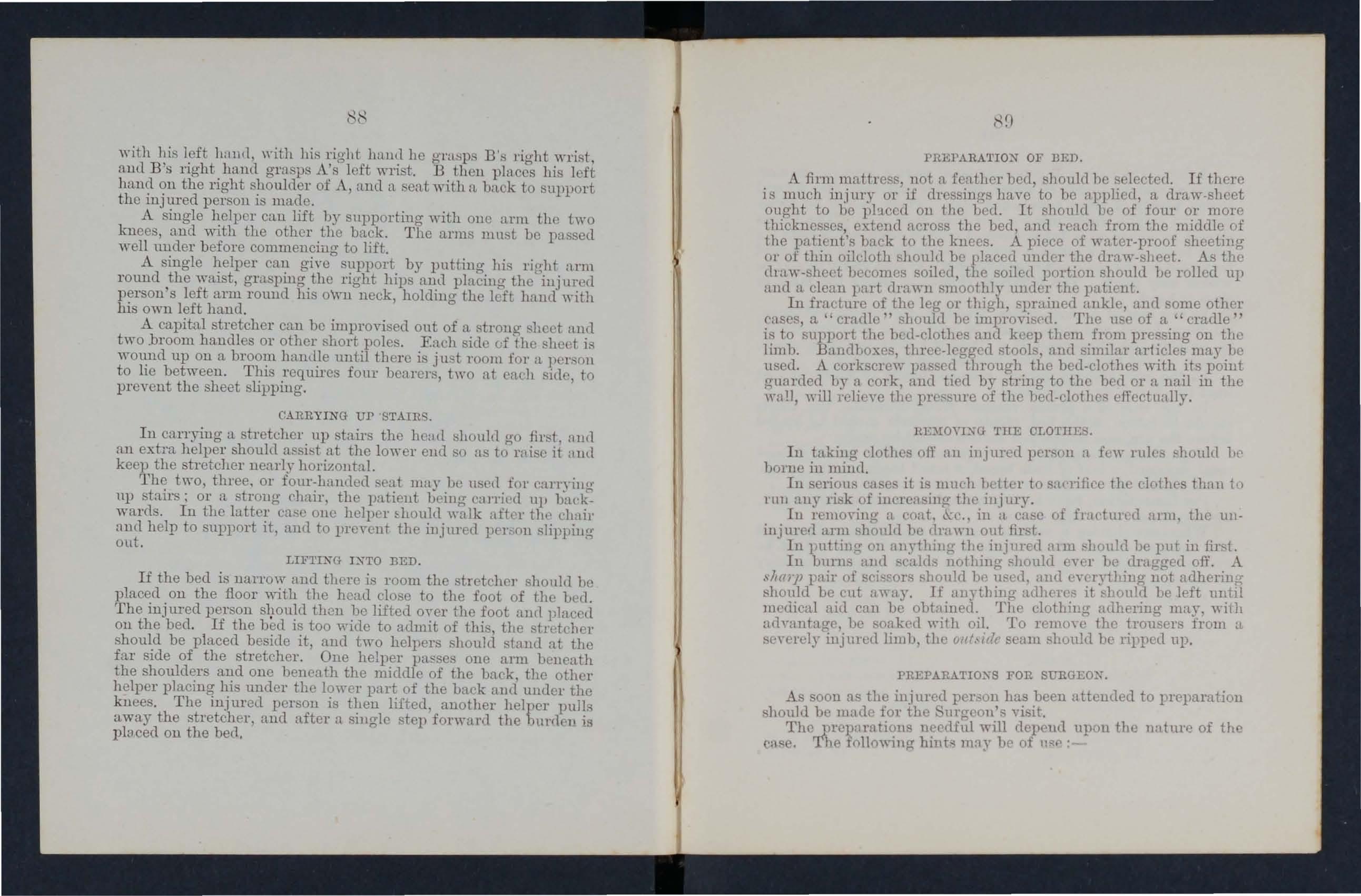
OF mm.
A firm ma.ttress, not a feather berl, shoul(] he If there is much injury or if dressings 11aye to be apphe(l, a draw·sheet ought to 1le phccd 011 the lJed. It should be of foUl' 0.1' more 1hicknesses, exteml a.rross the bed, and reach from the Jl1Jdclle. ()f 1he patient's hack to the knees. A picce of water-proof sheeimg or of thiu oildoth be placed ulltk'r the dmw-tllleet. As the thaw-sheet 1)ecoll1es soiled, the soilcll portion s1.lOuld 1)e rolled up amI u clean l,art drawll smoothly uuder the patIent.
In fracture of the leg or tl.ligh, ankle, anrl cnses, a "crn<lle" l>llonld he nnpl'ontird. u. r of a. clUllle is to SU]1port the 1lcll-clothes and keep them ,ir?JIl on tlll; limb. BUllcllJOxes, three-legged stooh, aIlll :;111111ar . mny .be II 'ed. A corkscrc\,; through. the bed·clothes WIth .lts. POlllt guarded llY n cork, and heel by trUlg to tllO beel or a lIall ill the ",:111 will rrJit'Ye the of thc lle(l·clotllr:" effectually.
H}-;)1OYL'O TIrE CLOTnE::l.
III takiug dothes on all illjurec1 persoll a few nIle's 11(' l)ol'll e ill miud.
III se1'ion:< case" it is llIu('lt 1'ctter to sal riticc the c:1C,thl'S thall to Illll allY ri.;;k uf iJlcreasillg' tllL'. iujury. ,
III relllO\'illg' [1 coat. L\:I'., 111 a ca:<e of fl'll!'turet] :nm, the UlI· illj urer1 arm sholll,l be dnl\l'u .first. , ,
In l111tting 011 t1IE: IIlJnretl :Ilrn :-1 10 ulc1be pnt III
III unrns awl :<cahl. I101hmg should oyer bc .tlraggcc1 off .. .A sl/{Ii'jJ pair of sci.-sors l>houlc1 be l1,;C,l, and CYCI)1.hlllg not adherlll"';· l>hould be cut away. If tlllything adhc!'!):" it be left metiieal ai(l call be obbined. The clotlm!g adhenng may, wllh arlnmtage, he :<oukcd with To remOH' the from a sC'\'crely injured liml), the {Jilt, lilt' scam be nppell up,
PREPARATIOXS rOR SURGEO_'.
As soon as the injured per:.;on has been attended to preparation , houl<l be made for the Snrgeon'" yisit. , Thr. l1l'cpnrntiolls 11(('(1£ul will rlepelHl l1pon the of tit rnse. The fnllrm-illg hint" m:ly lIe of IIRr ; -
flO
A. nrc in the room ,,-ill generally be of sCIyi('p, ("'('11 in flUlllJl1('l', There should be plenty of \\ater, both hot and cold, also scyeral basill , plenty of clean towels and soap, There shoulll ue something' to empty water into; a. foot-bath lloes wclL The basins shoUld be placetl on a, taule, coyered with a clean ,,'hite cl()th; <l large to,...-el makes a suitable cloth; the towel, folded up, should be placed on tho same table, und the hot amI cold water shoulll be within easy reach. The foot-bath should bo uuder the taule 01' close at hand.
Iu the case of a burn, cotton wadding, soft cloths, old linen, oil, flour, broad, and soda, should bo ready, aucl materials shoull1 1)e torn up for ba.ndagos. If 11 Chemist's shop is within reach, Carron oil and plenty of cotton wool should be sent for.
In the case of hmmorrhago, sponges, pI out)' of ,ruter, ancl at least h,o bllsills should be rea(1),.
In the case of a person rcscued from chowning the sheets should be taken off the bed, plenty of blankets should be hen tell beiore the fhe, and seyeral hot bottles should be ready.
If poultices are likely to he required, boillllg watcr, linsl't'll meal, mustard, a loaf of stale bread, a small basill, a large i"poon, s"eet oil, and tow, flalmel or handkerchief may ue r('(llUl'ed.
For fomentation, have hoilillg ,,'ater, flannel, a kitchen roll '1', nml hvo sticks, 01' a large towel.
When snmmonillg a mellical man to an accillent alway;; let him kuow what killd of caso ho is require{l to treat, so that ll{l may bring whateH'r is needful. By meults "alual'le tiltH! lll:t.\· UC H1YCCl.

INDEX.
13
Acids, y, fi:1
Air cells, :!·1 ,\1cohnl, by, <18 " "fi:l
Aucdomy, 1:> Allimn.ls, bitt!1> of, :,0 4.5
Al\.!hes in fvot. lli Arms, ]7 . .'l..l'Ill-slillg, small. " " large, (j!)
Ann, fmctul'o of, ;is
Arteries, Artery, brachial, ::!!)
" face of, 31 femoral, ::;2 IJcatl uf, :·n or, 31 subela. 'ian, 1, 31
" pul aHon in, 22
Arteri:tl LIed.iug "27 of, '2( treatml'llt
.A.rtincia.l r""l'il,,\ti'I!I, ;'1 .A I'rie}!'!! , :z 1
n,\LL S()CKJ::T JOINT, 1'j HUl1(lages, 6:1
Bl'arers, 2 for shdchel', 7f) :i " 1:):1
" -1" " Delly, 1.)
Eites of ;,nilll.lIs, F,O
Hlee,ling fllJll1 l IllI, " "r.l!npit, 20 e(11'8, 3;") fout, fore aim, :2'1 lle:Lll,31 Ie.;, 33 lio,c ,27 palm, :!S
" "thigh, 32 Hlvotl, u e of, :n illlPl1l't', 21
" pure, 20 BOlles, 13 BOliO, brut eh, },j collar, 10 hauIlch, 1;) rump, 15 sbin, 1U n lr·
--+-
Bone, brok en, 33 " disloca ted, 35
Bra.chial artery, 2!)
Emin, compressi on of, 41i " ccncllsalon of, 4G stertorous, 45
DUllLS, 48
CAPILLARIES, 21
Capillary bleeding, 26 " treatment, 2G
Carbonic acid, 23
C:tITying 71
Cartilage, 17
Cervic.al v('rtebrre, 1-1
Chest, 13
.llioroform, poisoning by, If!
Ci.rcnlation, orgalld oi, 1\)
Cl:wicle, 16
Ova t stretcher, 73 (Jolla!' bUlle, 10
Comminntfd fracture, 34
Coruplicl'lteu 34
Cou:pound " 33
Compresf)ion of hrain, 4.3
Con (,llssion " 4fi . 15
34
Cuts, 53
DJAGRA:tl OJ, REAlI'r, 20
Di?pLra,;m , 24 bigns of, 35 " treatment, 36
Distortion in fracttu'es, 3-1
Dorsal H
Dress on tire, whn.t to do, 52
Drownin[t,54
DrunkclllH's!';, 4S
EL,\STlC R\);DAGE TOl'm,I28 4:)
Esmarch's i'Hll,lnge, .6xpimt.ion. 2;-)
Eye, for ibn Llllly in, !)3 47
F::tlling Sickness . ·\:i
J'emora.1 Artery, 32 :Fcmur,1;; .Fiholll; l'ibula. Hi
1 iUtirJ', 1'01)(-:; in, 17
Fi.re, ure"s 011, f):2
Foot. lti
I'ore ig:l hod J' in ey", :::1
Four-ltnndc!l scat, 71
Fractun·s, :::3
Feu t.U!'C t.f :1I nt, " c01lal ' ]'one, " forc-arln, :-{:'" " " hal1d. " j '\ : knee.e,'p, 1:; " 42 " l'ihs, " 3·1 thigh, 40

Fractur e, signs of, :3-1 cOllllninutetl, 1 complicated, 34 compounu ,33 simple, 33 , , distortion in, 34 Frog's ma.rch, 73
GA'l, BY, 40
H.d.::}fORRlL\GE, 26 al terin l, 27 cnpillll'Y, " V('lWItS, Hand, of, ;'iJ
Hanging, :i!
Haull<:h-bulIe, 15 H a.l,H
" injuries to, 4(j IIc'1.rt, 20
" diagram of, IJ sounds of, 22 " \-alves of, :;::! UinL"e juint., i7 1 <lllllcrus, 17
" fracture of, ;::; Hysterical tits, 50
L\ll'URE BLOOD , 21
Insensi.bility, cause of, -1<1 " examination ill, 45
Inspiration, 2-! Intoxic ation, 48
JAW, 11 fmcture of,
03
Joint, 17 cartilage in, 17 l ubrication of, 17 kinds of, 17
K::-rEE-CAP, 16
LAtJDfu"'<UM POISONIKG,49 Leg, IE)
" fracture of, 42
Lumbar vertebra:, 15 Lungs, 23
l\ImmFF,24
Muscles, 18 at rest, 18 in action, 19 structure of, 19 tendons of, 19
.i.. T £11.\,E" , )fOrOR. 2;) sensory, 25
" sympathetic , 26 X ervuus sytitem, 25 J. Toe bleeding, 27
POISONLTG, 49
Organs of circulation, I!)
" respi.ration, 22
Oxygen, 25
P .'I.IN IN FRACTURE, 31 Palm, bones in, 17
Pelvis, 15
Pick-a-back carrying, 72
Poisoning by acids, 53
" alcohol, 48
" alkalies, 53
" chloroform, 49
" gas, 49
" " opium, 49
Power, loss of, 34
Pulsation in arteries, 22
Pure blood, 20
RABID ANIMALS, BITES OF, 50
Radius, 17
" fracture of, :18
Respiration, 24 artificial, G-!
Ribs;'lfi organs of, 22
" fracture of, 39
Rump bone, 15
SACRUM, 15
Sack stretcher, 73
Scalels, 51
Scapula, 16
Seat, 2-haneled, 72 3-handed, 7"2
" 4-handed, 71
Shin-bone, 16
Shoulder blade, 16
Signs of dislocation, 35 fracture, 34
" insensibility, 41
Simple fracture, 33

Skeleton,
Skull, 14
Sling for arm, 69
Sound of heart, 22
Special fractures, 3;)
Spinal COI'd, 15
Spine, 14
Splints, temporary, 42
Sprains, 52
Stimulants, 45
Stretchers, 79
" temporary,
Sub-clavian :lrtery, 30
Suffocation, M
Swelling in fracture!', :-31
TEMPORARY
Tendon, use of, 10
Thigh-bone, 15
" fracture of, 40
ThoTax,13
ThI'ee-hfluded seat, 72
Tibia, 16
" fractUl'e of, 42
Tobacco, use of, dangerous in bleeding, 23
Tourniquet, temporary, 27
Trachea, 24
Triangular bandage, 63
" broad, 64
" narrow, 64
" for back, 70
" "cheek, 66 chest, 70
" (;ye, 66
" foot,' ,
" forehea<l, 66
95
'I'riHllgulal' bandage for h:Uld, 68
" " "hip, G7
" ja;w, 66
" seall', 64
" " "shoulder, 66
Trunk, 13
Two-hande<l scat, 72
ULNA,17
Use of blood, 20
V ALVES OF ilEAltT, 22
Varicose veins, 27
Veins, 20
Venous bleeding, 21)
Ventilation, 25
Ventricles, 21
Vertebral column, 14
Vertebrre, cervic:ll, 14
" dorsal, 14 lumbar, 15
\VHAT TO DO WHEN DRESS
OATCHES FIRE, 52
Wind-pipE', 24
\Vounds,53
Wrist, 17
l'nllte'l L,) CAEl;}; LL &: COMI'A,:", LIMITED, La Belle S:lUHlgC, 1 UUdUll,E.C
FOR NURSING GLASSES
(SECOND COURSE).

HINTS AND HELPS FOR NURSING AND IIYGIENE.
A FOR ALL HAVE TO DO WITH SICKNESS.
.Arrangcd according to thc Syllabus of thc Second (or Nmsing) Oomse of Lectures, by E. llicDOWEL OOSGRAVE, B.A., n.D., OH.B., L.R.O.S.I., Lectmer and Examiner to the Association.
Price la.; by post, la. Id.
Application j01' copies to be add,'essed to the Honorm'Y IJi"ector oj St01'e8, S.J.A.A., St. John's Gate, OlerkenweU, E.O.
J\,mbulantt J\,ssodation, Horse Ambulance Oarriages.
Estimates, which vary from £40 to £150, inclusive of all fittings, can be had on application to the Bon. DirectO!' of Stores,
For List oj place8 supplied vide Stor" Report.
The "Ashford' , Litter I
Weight, complete, with Stretcher and Cover, 1 cwt. Price, complete, £11.
With Telescopic Handles to Stretcher, lOs. extra.
To meet the requirements of small towns and villages, the under-carriage of this Litter has now been adapted to a double purpose, and it can be used not only with a stretcher, but also with a bier, thus obviating many inconveniences connected with the present system of conducting Funerals in rural districts.
Litter, with interchangeable Stretcher and Bier, complete, £13 13s.
J\.mbulanc£ J\.zzotiatiou. "Furley" Pattern Stretohers.
Ordinary Folding Stretcher, weight 25!lbs. £2 2 0
Do. with Telescopic Handles 2 10 0
Military Stretcher, exact size of Army
Regulation Pattern, weight 27t lbs. 2 5 0
Police Stretcher, very strong and provided with Straps... 8 8 0
At the International Health Exhibition, 1884, a Diploma of Honour was given to this Association, and Two Gold Medals were awarded to Mr. John Furley for Horse Ambulance Carriages, Litters, Stretchers, &c., designed by him j and at the International Exhibition held at Antwerp in 1885, a similar award (the only one given for such exhibits) was made to the Association for the " Ashford" Litter and for Stretchers.
All applications for particulars and aU orders should be addressed to the Honorary Director of Stores, ST. JOHN AMBULANCE ASSOCIATION, St. John's Gate, E.C.

INVALID TRANSPORT OORPS,
For the Conveyance of Sick and I nj ured Persons. (Infectious Cases Excepted.)
CHAIRMAN: Sir E. H. Sieveklng, M.D.
HON. SURGEON: Edmund Owen, Esq., F.R.C.S.
Rupert C. F. Dallas, Esq. \ Walter Pearce, Esq., M.D. Lieut.-Colonel James Gildea. Major Sir Herbert C. Perrott, Norman Moore, Esq., M.D. Bart.
nON. SECRETARY AND MANAGER: John Furley, Esq.,
To whom all communications should be addressed, with the addition of " Transport Corps" in the upp er left-hand C01'ner of envelope.
SUPERINTENDENT: MR. W. J. CHURCH BRASIER.
Horse Ambulance Oarria[es, Litters, Stretchers, and Oarryin[ Ohairs.
A Horse Ambulance Carriage, including all charges, from One Guinea to and a for a removal within the four-mIle radius of Charmg Cross.
A Two.wheeled Ambulance Litter, all charges, Half-a-Guinea within the four-mile radius
PRICE
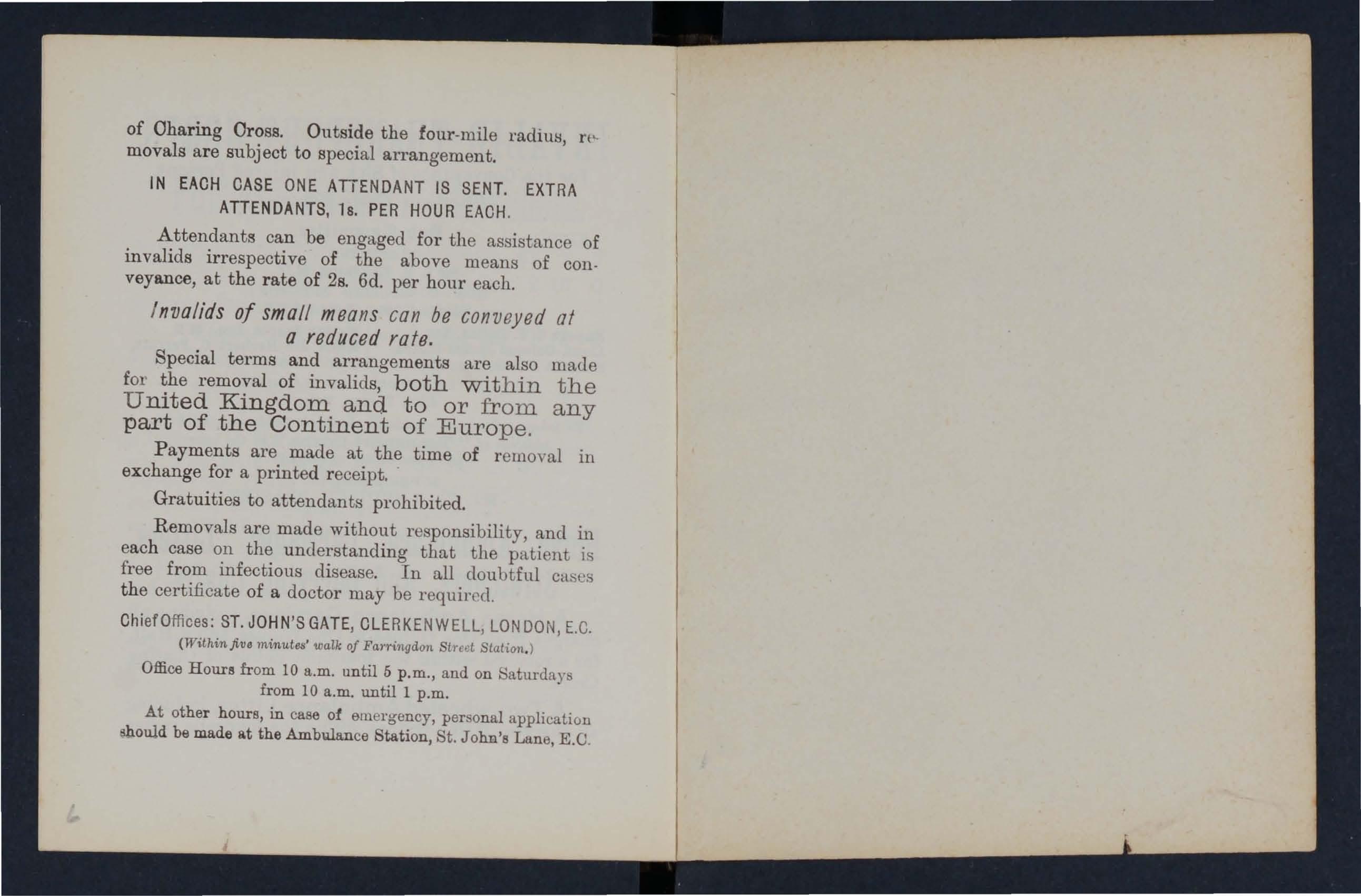
of Oharing Oross. Outside the four-mile radiUl:l, r{'movals are subject to special arrangement.
IN EACH CASE ONE ATTENDANT IS SENT. EXTRA ATTENDANTS,
18. PER HOUR EACH.
Attendants can be engaged for the assistance of invalids irrespective of the above means of conveyance, at the rate of 2s. 6d. per hour each.
Invalids of small means can be conveyed at a reduced rate.
Special terms and arrangements are also made fOl the removal of invalids, both within the United Kingdom and to or from any part of the Continent of Europe.
Payments are made at the time of r emoval in exchange for a printed receipt. .
Gratuities to attendants prohibited.
Removals are made without responsibility, and in each case on the understanding that the patient is free from infectious disease. In all doubtful cases the certificate of a doctor may be requirC'c1.
Chief Offices: ST. JOHN'S GATE, CLERKENWELL, LONDON, E.C.
(Withinfi1l6 minutllS' walk of FarringdOll Station. )
Office Hours from 10 a.m. until 6 p.m., and on Saturdays from 10 a.m. until 1 p.m.
At other hours, in case of emergency, personal application should be made a.t the Ambulance Station, St. John's Lane, E.O .
